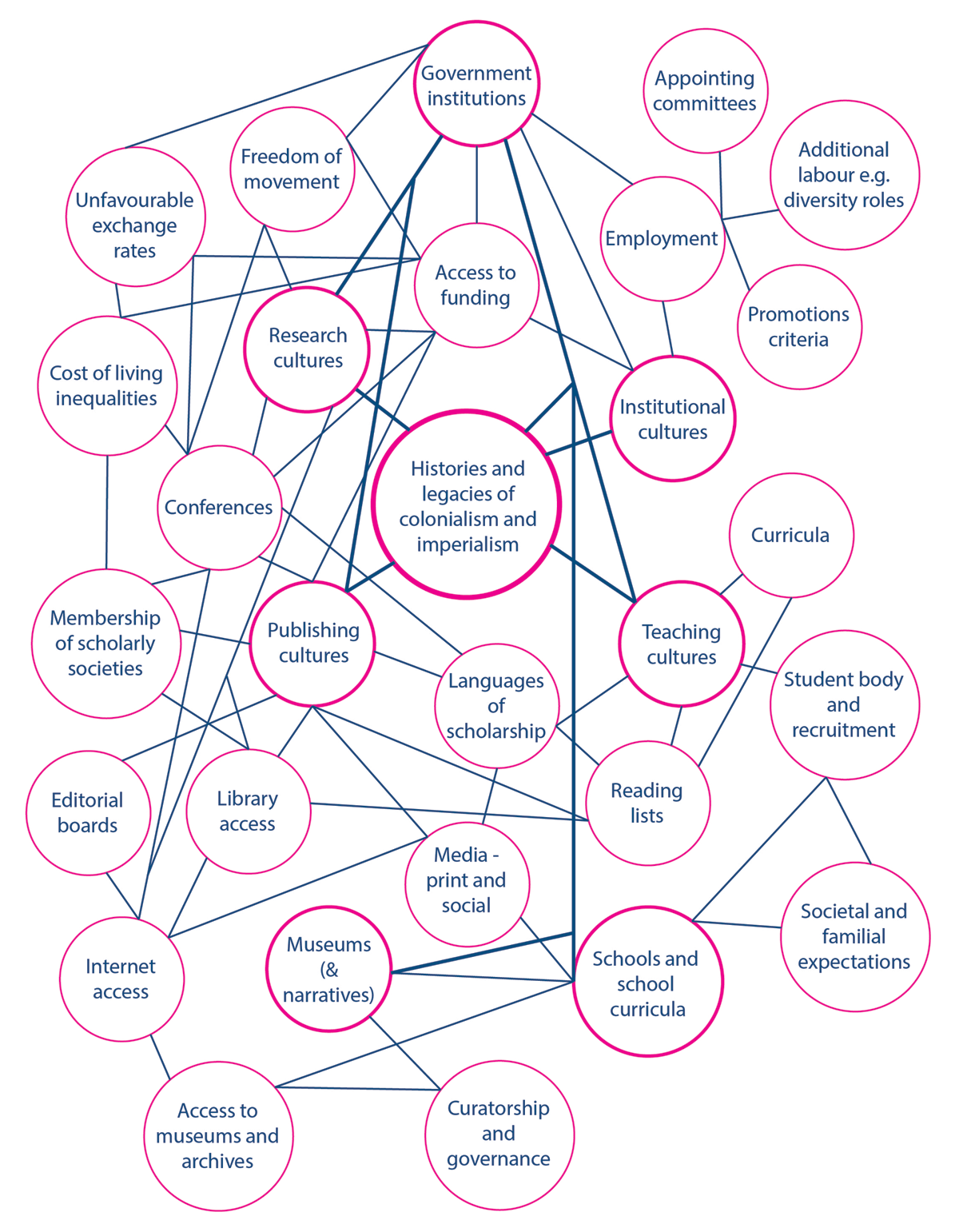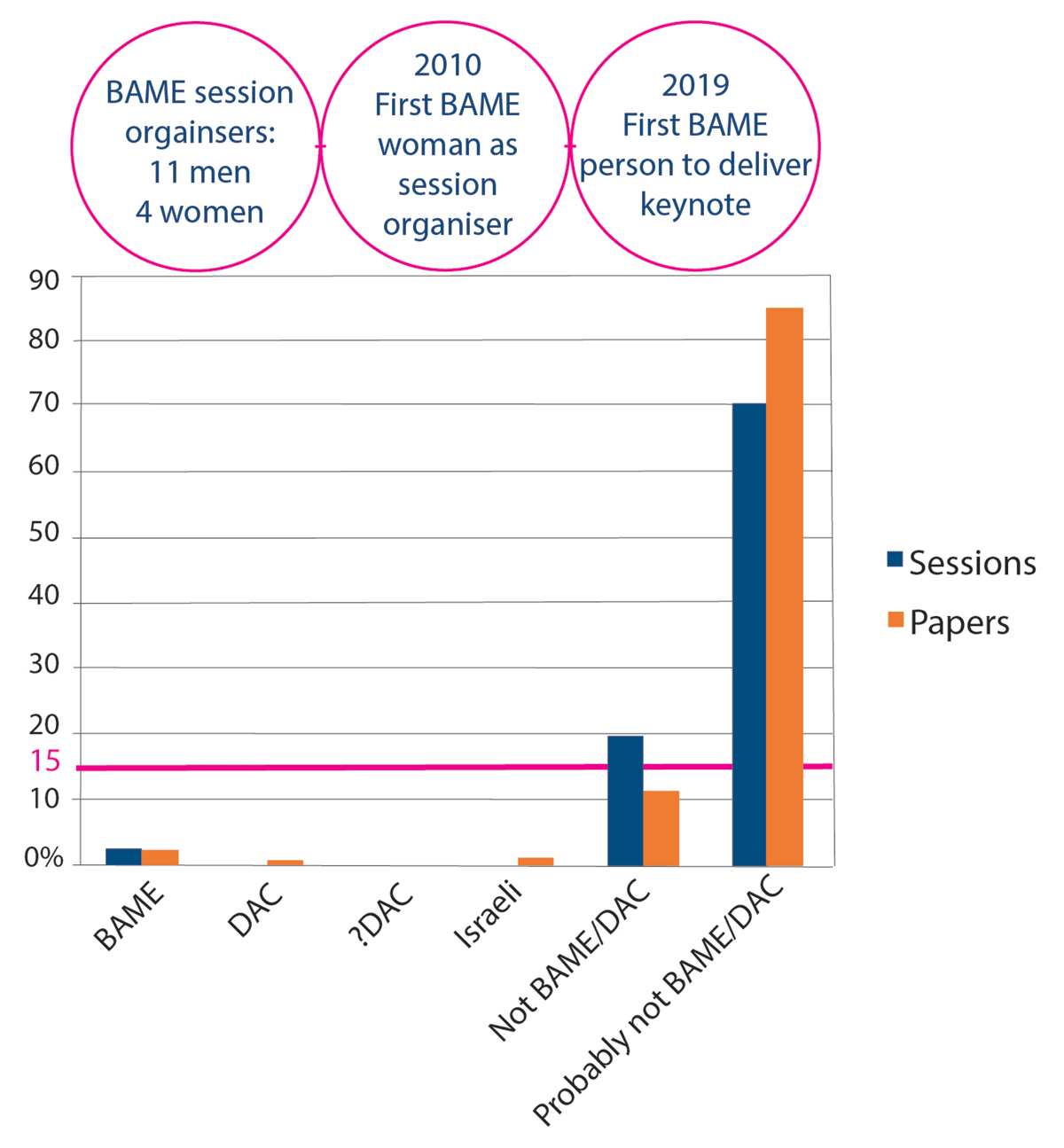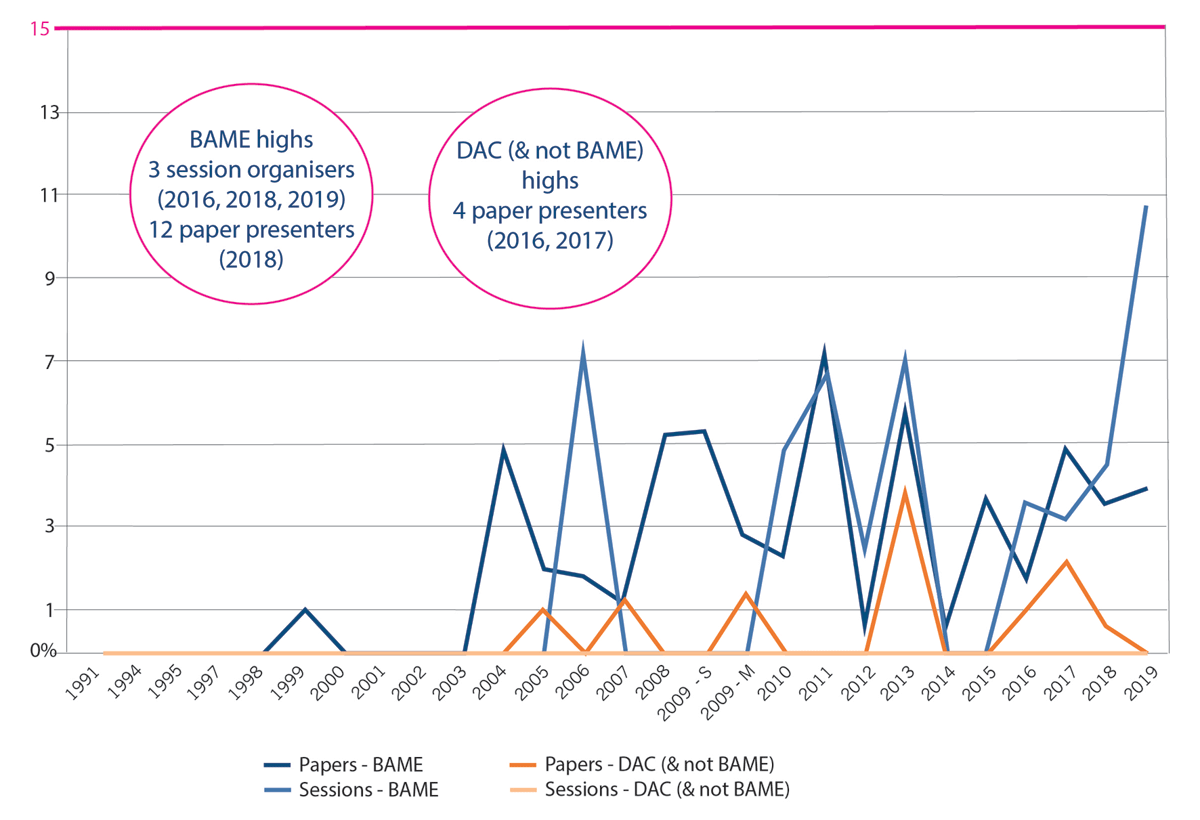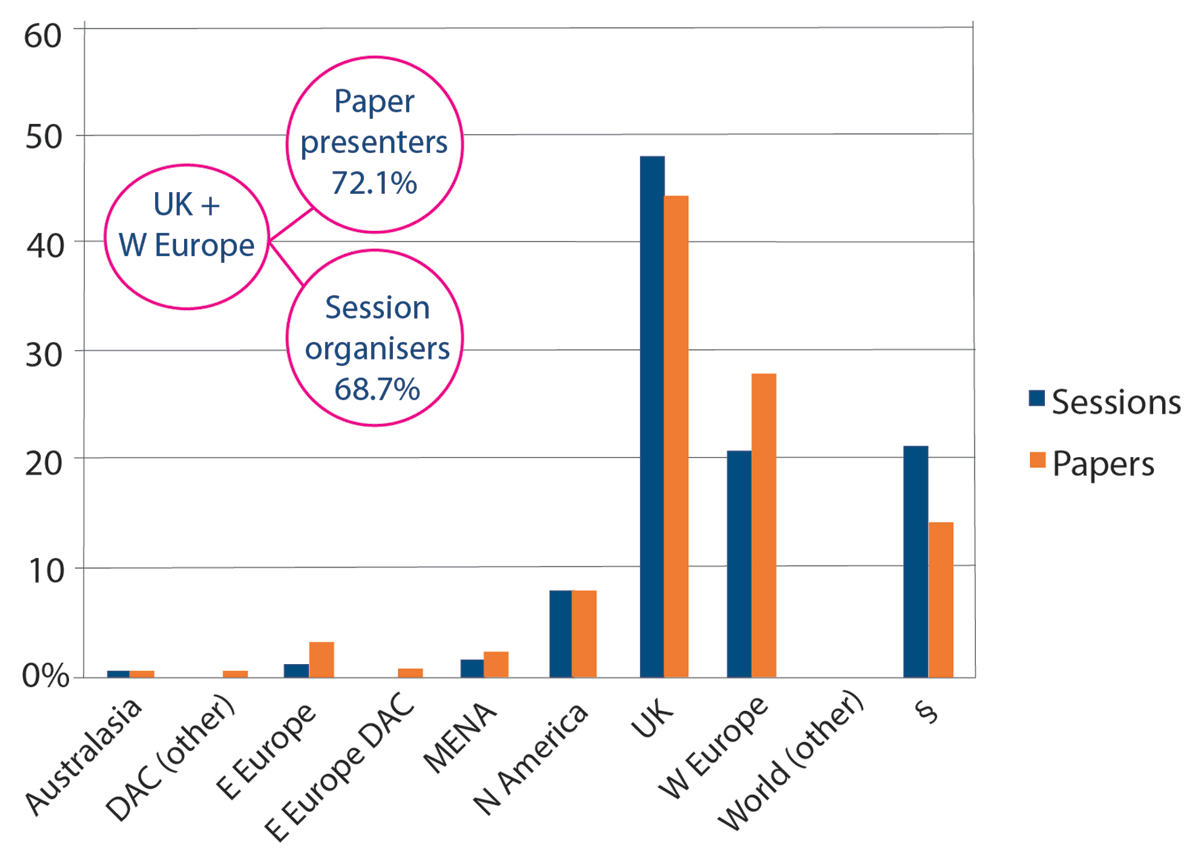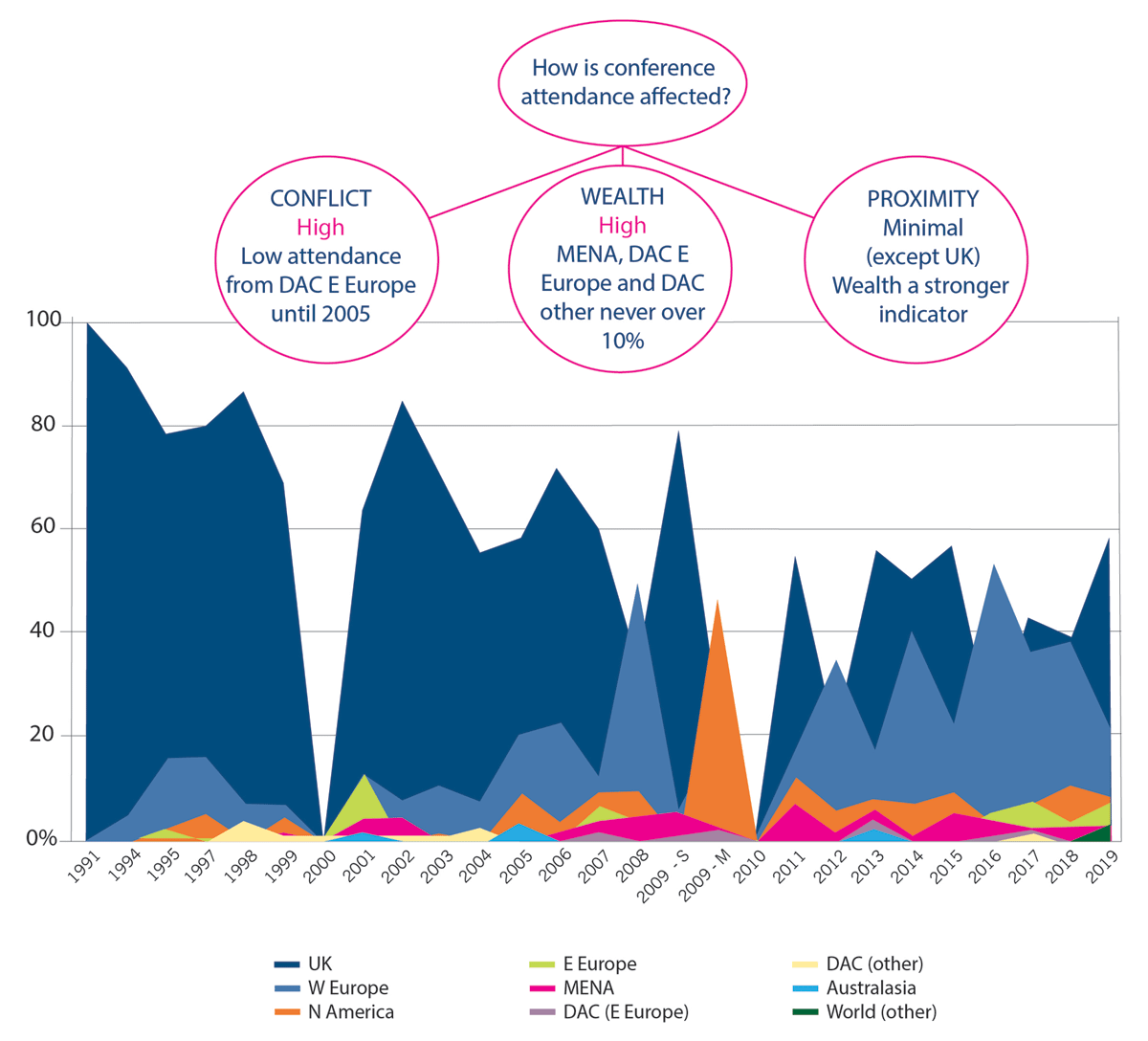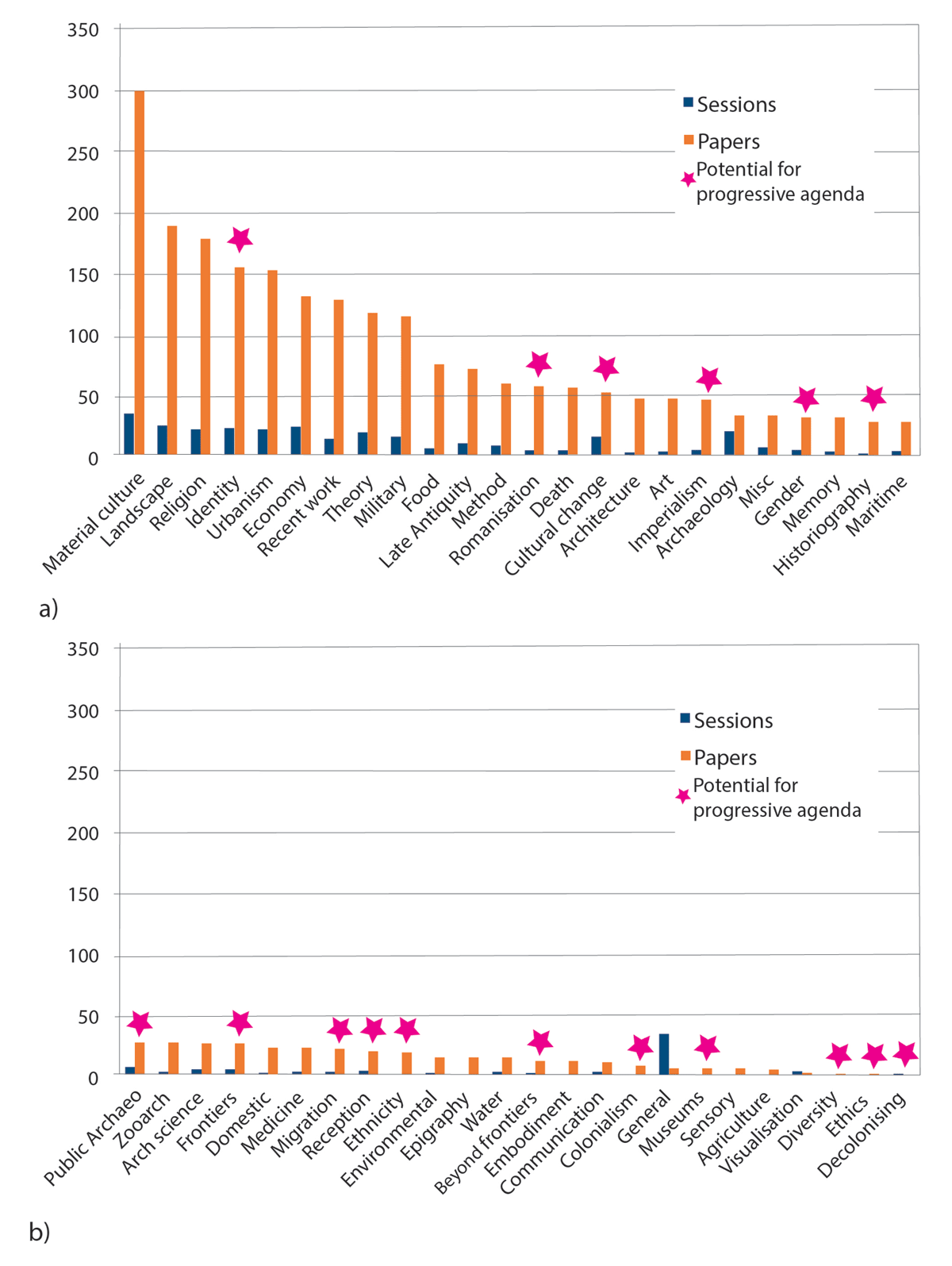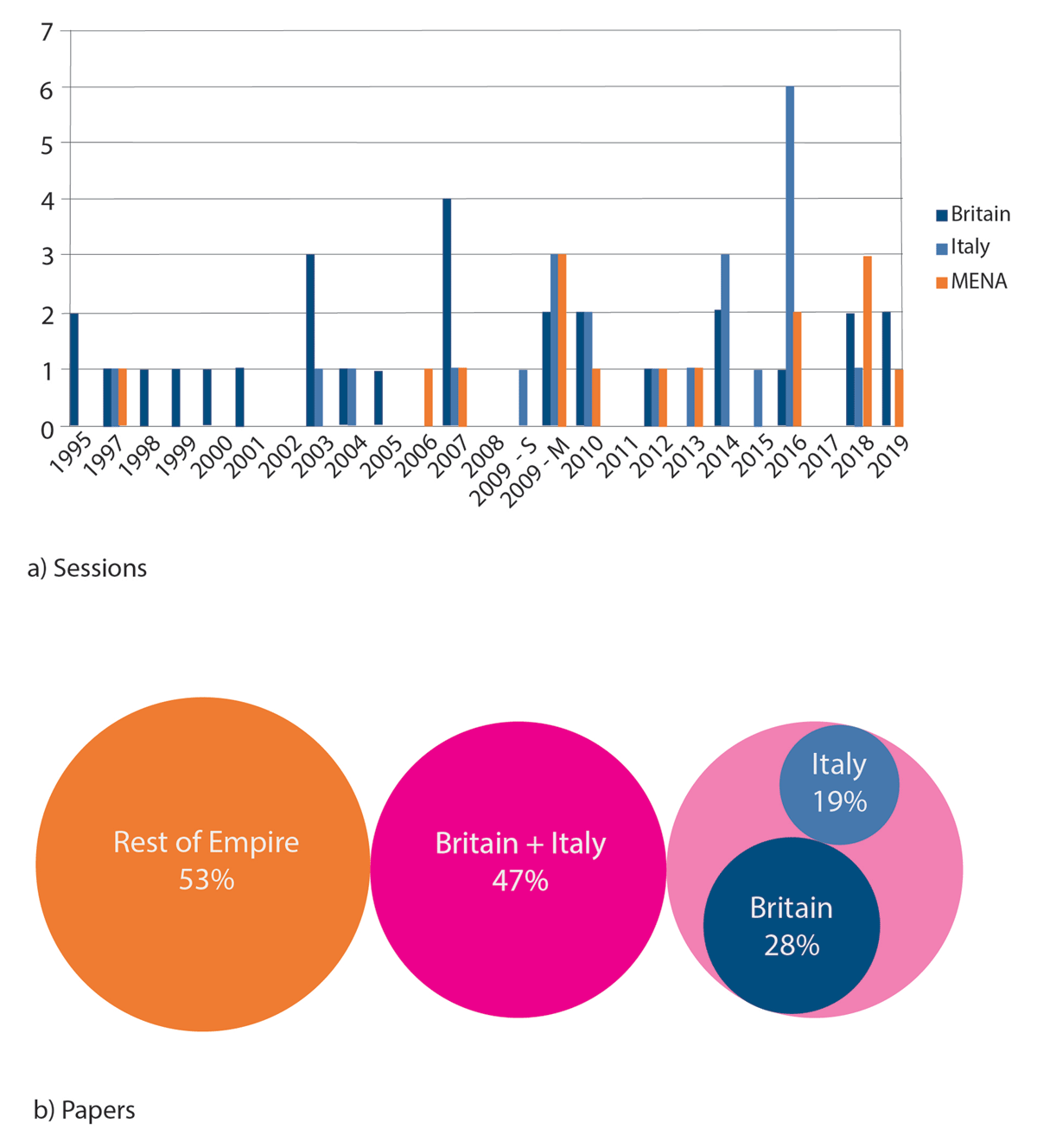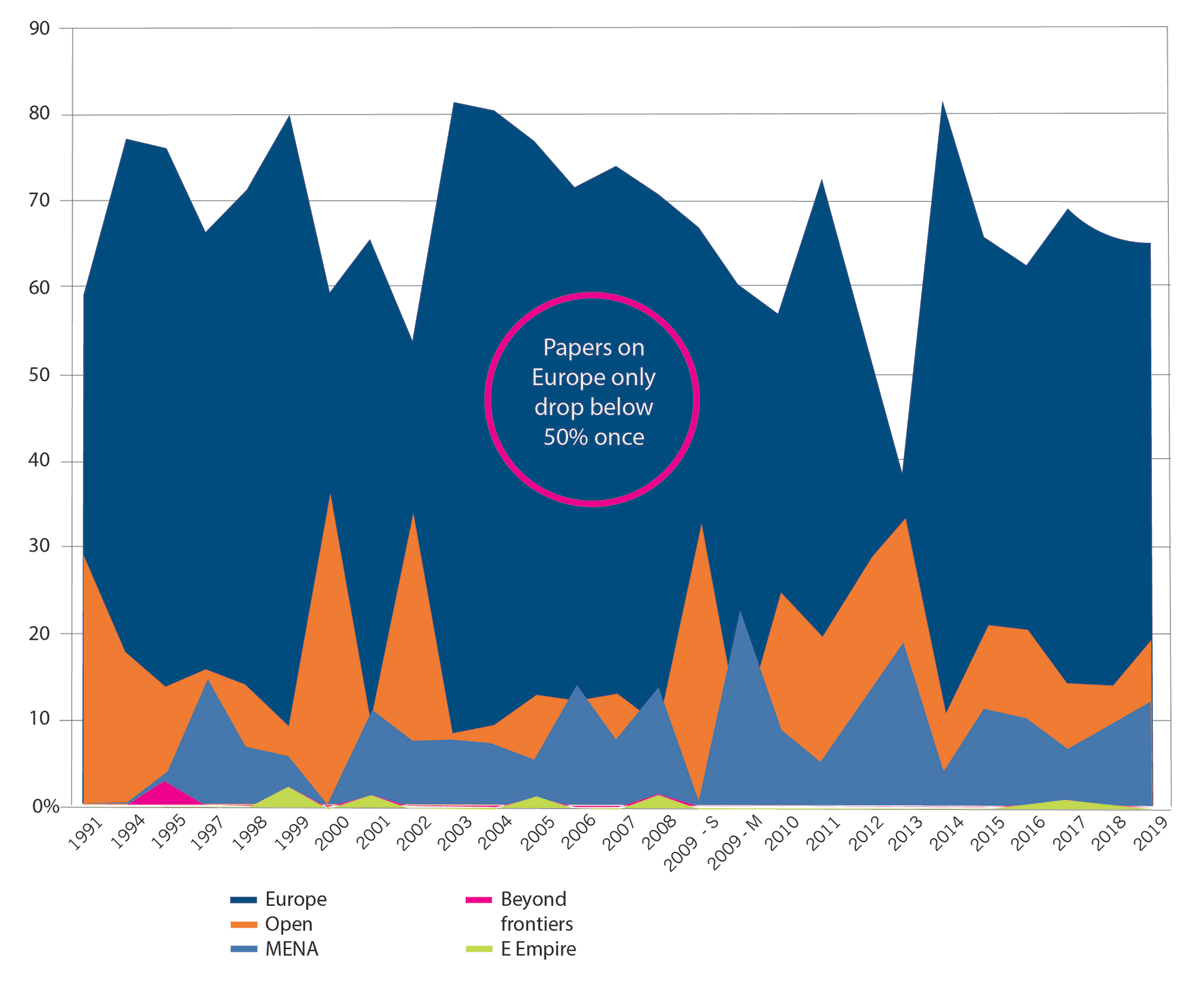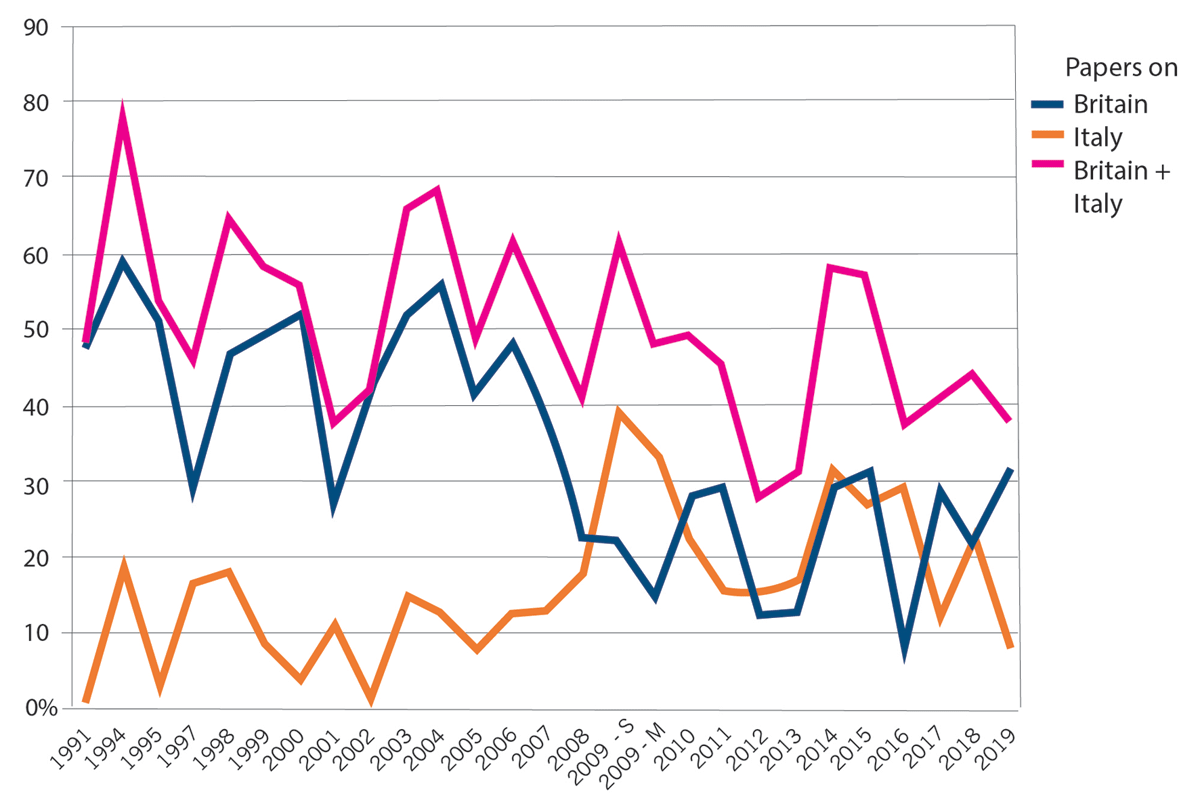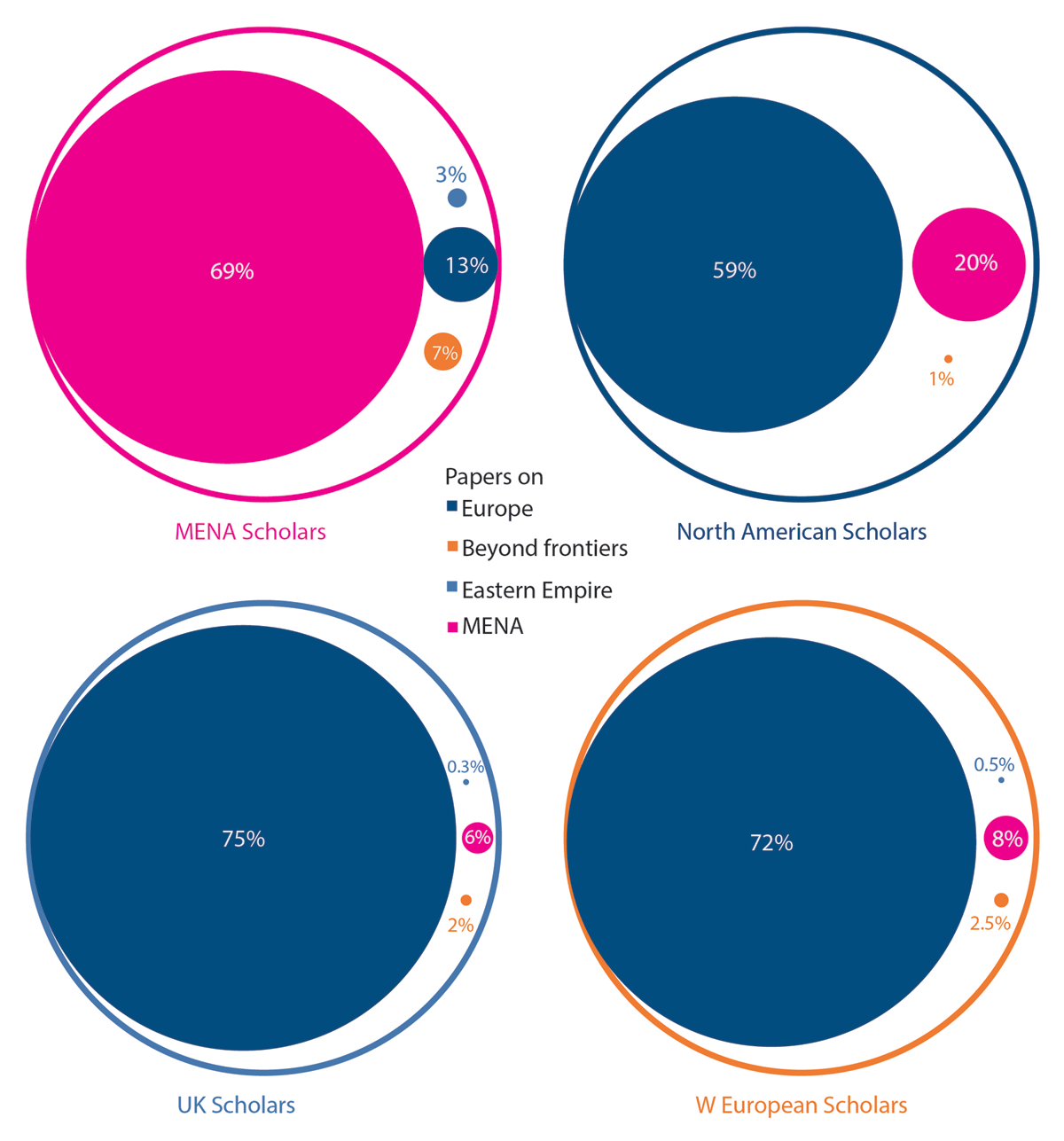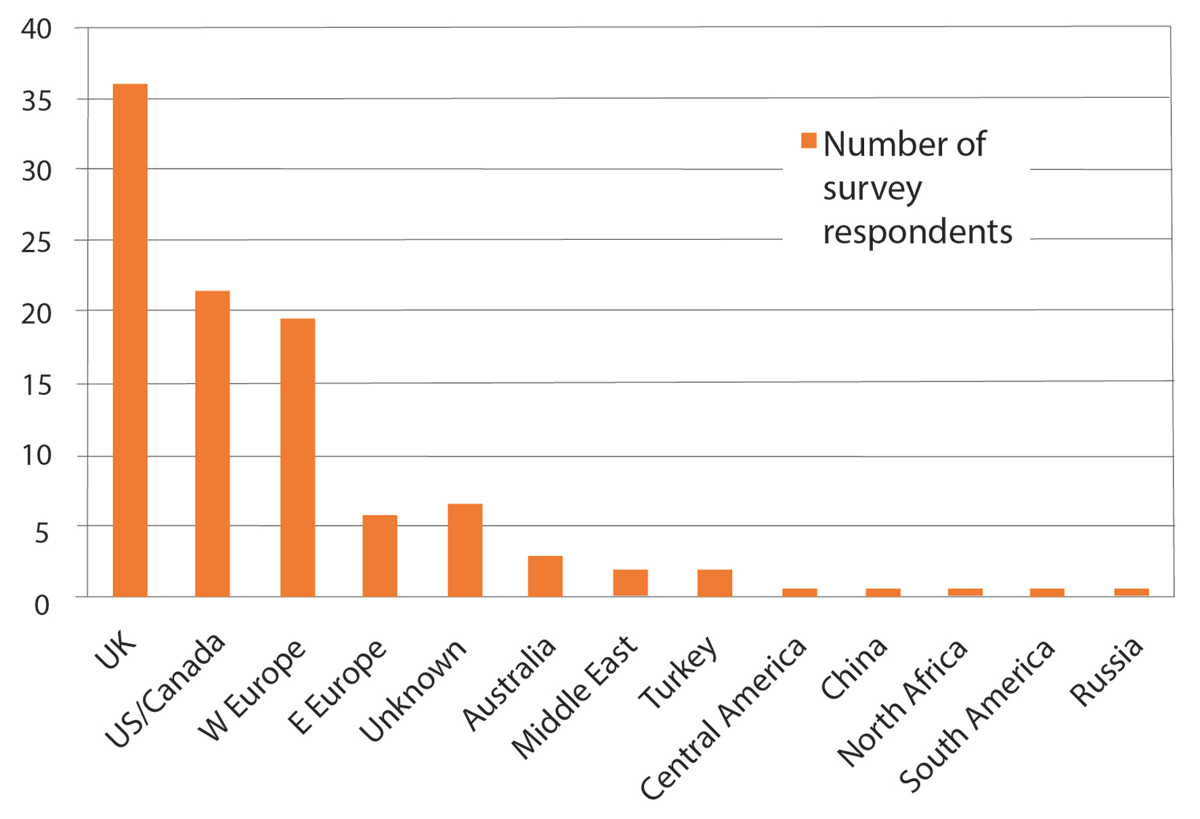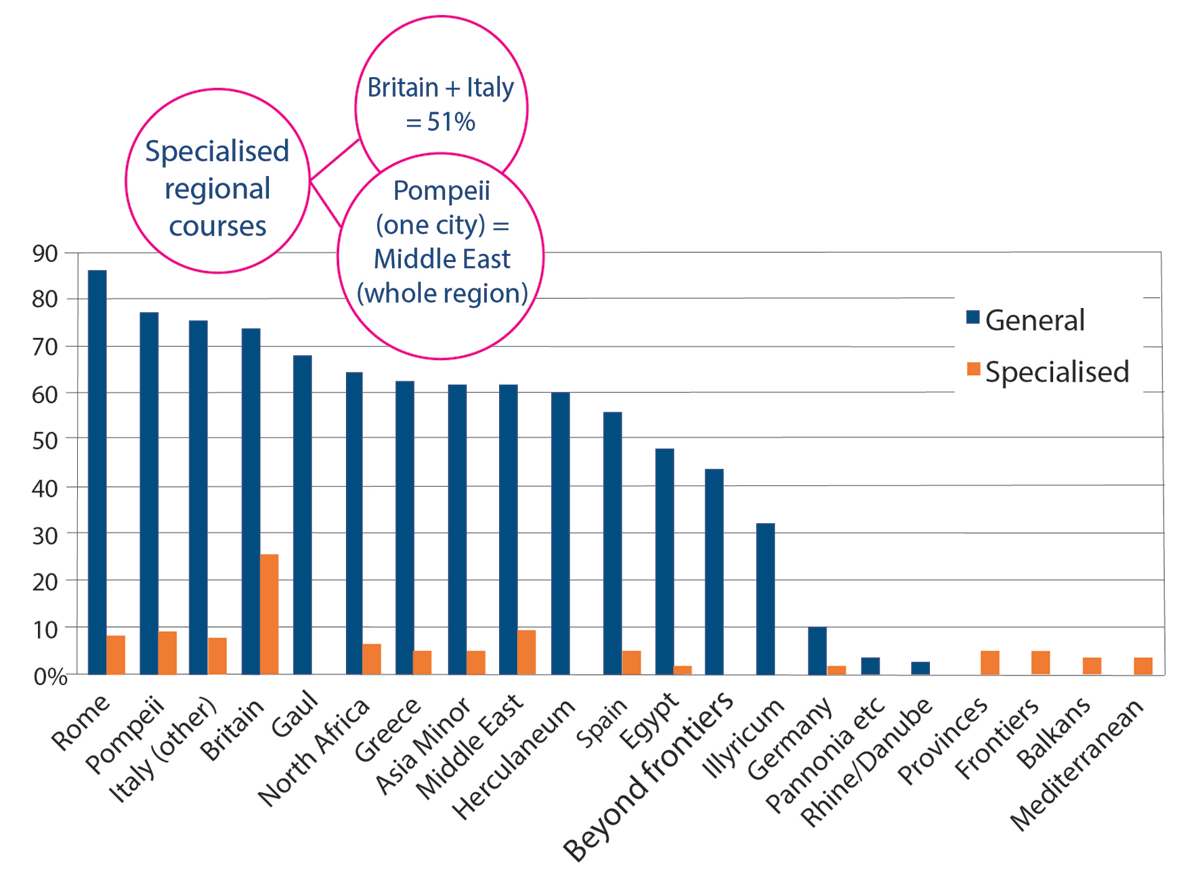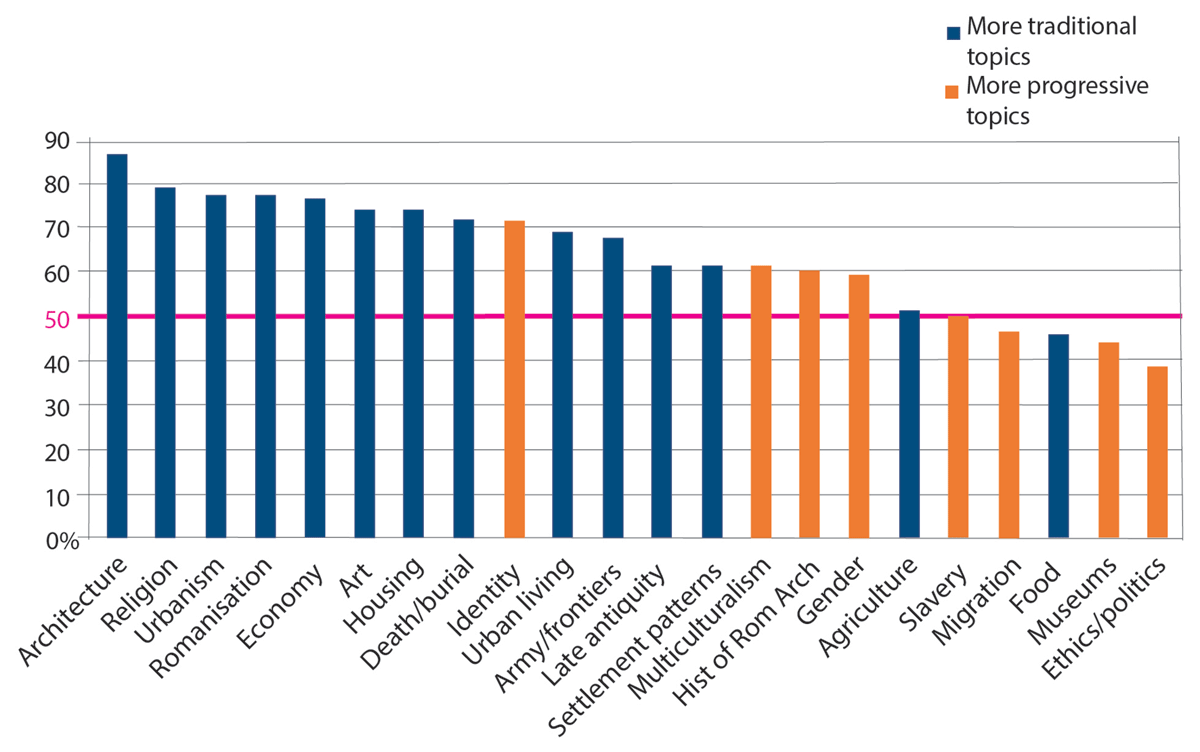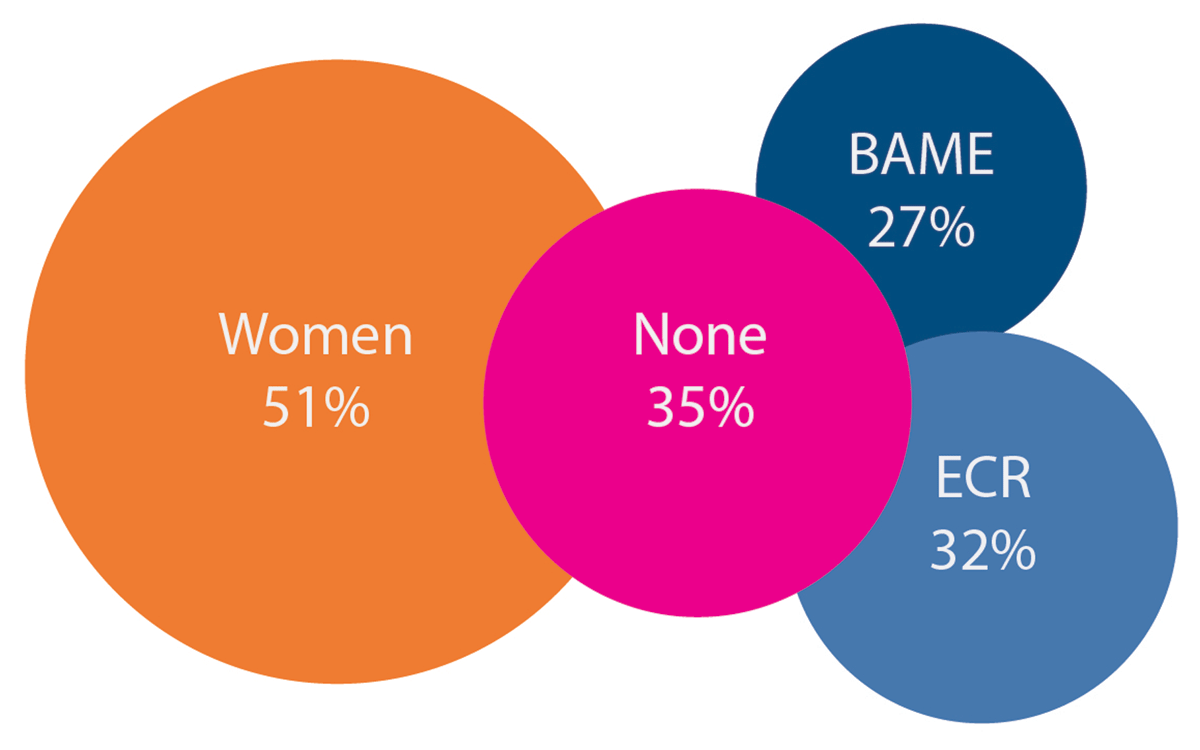Introduction
This article began life as the keynote lecture for the Theoretical Roman Archaeology Conference 2019 at the University of Kent. The aim of the keynote, and of this article, is to analyse the current state of our discipline, particularly its decoloniality and inclusivity. The choice here of the term ‘decolonial(ity)’ is deliberate and echoes the use of Mignolo (2011) in order to focus on moves to disrupt the structures of power and knowledge that have their foundations in western modes of thinking and acting (for further discussions of terminology, see Decolonial Dictionary 2019). This discussion is set against a background of widening calls for ‘decolonising’ academia (Behari-Leak et al. 2017; Gopal 2017; Bhambra et al. 2018; Chantiluke et al. 2018; Deb Roy 2018; Henriques and Abushouk 2018; El Kadi 2019; McDonald 2019; Muldoon 2019). The 2018 Royal Historical Society (RHS) Report on race, ethnicity, and equality (Atkinson et al. 2018), which included Archaeology within its purview, highlighted significant issues around underrepresentation, discrimination, bias, and harassment in History in the UK. Similarly, the Council of University Classical Departments commissioned a survey and report on equality and diversity issues within the broad discipline of Classics in the UK, which also raised numerous areas for concern (Leonard and Lovatt 2020; for the US, see e.g. Allen 2020). Both reports also make recommendations on how to improve the current state of these related disciplines. These data cannot and should not be ignored, so it is encouraging to see that, for example, the Faculty of Classics at the University of Cambridge has taken up this challenge and issued a frank and honest response to an Open Letter. In the response the Faculty acknowledges the issues at play in the faculty itself and the discipline more broadly and, crucially, sets out a clear and specific action plan to tackle the identified problem areas (Cambridge Faculty of Classics 2021). Similarly, it is time to shine a critical light on Roman Archaeology and raise a call for action for all of us in the discipline.1
The lenses chosen for this examination are: conference data from Roman Archaeology and Theoretical Roman Archaeology Conferences; and data gathered by the 2019 Roman Archaeology Teaching Survey (RATS). Both lenses allow for different kinds of analysis and furnish complementary insights into the state of our discipline; both are marked by inertia and an apparent lack of willingness to enact fundamental change. The conference data, which span 1991–2019, allow us to look at any potential changes over time in who has been participating in the major research conferences of the discipline, the countries in which participants have been based, and the kinds of research being discussed for the past three decades; these are predominantly quantitative. The RATS data give us a snapshot of current teaching practices, linked to the places and topics we teach and who we put on our reading lists. In addition, the comments shared in the survey responses provide rich qualitative data to nuance our understanding of why people are teaching in these ways. Critically, I will demonstrate that the findings from these two lenses are linked, that research and teaching cannot be separated, nor can they be separated from wider external structures (Figure 1). In this sense, then, I do not advocate for calls that focus solely on ‘decolonising the curriculum’ as these will never be able to go far enough to enact the required structural change. Instead, I make a series of suggestions for actions that can be enacted by a range of people from students to journal editors and that move across a broad sweep from reading lists to visa regulations.
After this article was written and had been through the peer-review process, the centre of gravity across the world changed in two key ways: the global coronavirus pandemic and the murder of George Floyd on 25th May 2020 in Minneapolis, which led to increasing awareness of the Black Lives Matter movement. The tragic fate of George Floyd, in particular, has shed a painful light on structural racism in the US, but also far beyond. It has shown why there is a still a need to discuss issues around race in all aspects of our lives. In response, several institutions and bodies issued statements about the Black Lives Matter movement, for example the Cambridge Schools Latin Project (2020) and Multiculturalism, Race, and Ethnicity in Classics Consortium (MRECC 2020). This is my contribution to that conversation.
A note on the scope of this article
The purpose of this article is not to point fingers or apportion blame; rather it is about us collectively taking responsibility, both for the current state of the discipline and the actions we can each take to bring about positive change. The driving force behind this article is, predominantly, race and ethnicity. I recognise, however, that there are numerous intersectional issues at play here relating to gender, sexuality, class, religion, disability, and precarity; where possible, these intersections are drawn out. I would encourage readers to conduct more studies of this nature, so that we can begin to draw out these intersections with more nuance and understand in more depth what a fully inclusive Roman Archaeology might look like.
Acknowledging bias
Before analysing the data in depth, I would like briefly to acknowledge my own biases and privileges. Firstly, and for me most crucially, I am British Iraqi and grew up in the UK (on being of mixed heritage in the UK, see Hirsch 2018). I identify as a woman of colour, but I am ‘white-passing’, which gives me immense privilege in my day-to-day life as I can walk down the street, go shopping, etc. without being subject to many of the microaggressions and racist abuses that are a sad, difficult, and seemingly unavoidable part of life for many people of colour. As will be seen below, this has not protected me entirely from racism and microaggressions, much of which I experience due to my name, which is clearly not English. My family background is complex and tainted by the many conflicts Iraq, and my family in Iraq have suffered; again I have been subject to privilege by growing up in the UK. Furthermore, I have had the benefit of an excellent education, with undergraduate and postgraduate degrees from the University of Oxford.
My experiences as a woman of colour in academia have moulded my position strongly on this topic, such that I believe that diversity, inclusivity, and equity can only ever be positive in academia. In addition, my consciousness of my own biases leads me to believe that no piece of academic work takes places outside of our social, cultural, and political milieux and that to operate otherwise is misleading (of oneself and others) and potentially damaging (e.g. in not being able to acknowledge that one’s own background has influenced one’s work and so may have, inadvertently or otherwise, excluded other perspectives).
Conference Data
These data are drawn from the programmes of 27 Roman Archaeology Conferences (RAC) and Theoretical Roman Archaeology Conferences (TRAC) held from 1991–2019 (Table 1). TRAC has been held annually since 1991; RAC is held biennially. In years where the conferences coincide, the conferences are held at the same time and in the same location, but are organised by separate committees. The welcome page of the website for TRAC notes that ‘The first TRAC conference was held to widen the range of perspectives offered, and voices heard, in Roman archaeology’, which it claims has been a ‘major success’ (TRAC website n.d., emphasis mine; see also Garland 2021). While TRAC should rightly claim a success for the widening of theoretical perspectives in Roman Archaeology, in the following analyses, I will challenge the extent to which this has been a success in terms of inclusion and diversity by examining whose voices and perspectives have been heard at TRAC (and RAC) conferences in the past 30 years. I will demonstrate that those voices and perspectives have predominantly come from white academics, based at institutions in the Global North.
Conferences included in the dataset by year and location.
| Year | Location |
|---|---|
| 1991 | Newcastle |
| 1994 | Durham |
| 1995 | Reading |
| 1997 | Nottingham |
| 1998 | Leicester |
| 1999 | Durham |
| 2000 | UCL |
| 2001 | Glasgow |
| 2002 | Canterbury |
| 2003 | Leicester |
| 2004 | Durham |
| 2005 | Birmingham |
| 2006 | Cambridge |
| 2007 | London |
| 2008 | Amsterdam |
| 2009 | Michigan/Southampton |
| 2010 | Oxford |
| 2011 | Newcastle |
| 2012 | Frankfurt |
| 2013 | KCL |
| 2014 | Reading |
| 2015 | Leicester |
| 2016 | Rome |
| 2017 | Durham |
| 2018 | Edinburgh |
| 2019 | Kent |
The dataset includes two conferences held in 2009 in Michigan and Southampton; where relevant, these conferences are treated separately. A full run of conference programmes was available for 1997–2019. Conferences programmes for 1992, 1993, and 1996 are not included as programmes could not be found. In the data relating to sessions, 1991 and 1994 are not included as these conferences were not divided into discretely-organised sessions. The conferences have been held predominantly in the UK (23), with 1 in the US and 3 in mainland western Europe (Table 1). The conferences have never been held outside of the Global North; in 2022 RAC/TRAC will go to eastern Europe for the first time. This is our first hint towards the need for these conferences to reflect more fully the global reach of the discipline, its scholars, and their affiliations.
Programme data for the conferences was entered into an excel spreadsheet with separate pages for sessions and papers; anonymised versions of these data are available for download as .csv files (Supplementary files 4–6). Each session and paper has a separate entry that includes all named organisers/presenters, their affiliation, their gender, and whether they are BAME (Black, Asian, and Minority Ethnic).2 Gender has been allocated by first name; if first names were not given (i.e. only initials) or the gender of first names is ambiguous and may have been deliberately chosen not to conform to binary gender assumptions, ‘?’ is used to denote ‘unknown’. Whether organisers and presenters are BAME was substantially harder to deduce; where possible, it was cross-referenced with the RATS survey or based on name. I recognise that this is not a fail-safe approach and, in particular, that it will mean that some BAME people have not been identified, especially people whose name is ‘western-sounding’; this is addressed explicitly, where it might affect the conclusions drawn. To facilitate the analysis of the dataset, some elements have been synthesised, e.g. session topics, country of affiliation; this is made clear in the analysis.
Basic data for the 27 conferences can be broken down as follows:
Number of sessions: 384
Number of session organizers: 622
Number of papers: 2385
Number of paper presenters: 2850
Although gender is not the key concern of this article, in order to highlight issues around intersectionality, gender can be broken down as follows for session organisers:
Women: 193 (31%)
Men: 377 (61.6%)
Unknown: 52 (8.4%)
This shows that there is a strong bias in favour of men organising sessions. Paper presenters have a slightly more even gender representation, but men still dominate strongly:
Women: 1085 (38.1%)
Men: 1686 (59.2%)
Unknown: 79 (2.8%)
In what follows, I present data that allow us to examine the who, where, and what of RAC/TRAC conferences: who participates, where those participants are based, and what topics and parts of the Roman world are being discussed. It will become clear that there are deeply-embedded biases in these conferences, which have been slow to change between 1991 and 2019. I will end the section with suggestions on actions that can be taken by a range of people at numerous levels to enact the necessary change.
WHO participates in RAC/TRAC conferences?
All session organisers and paper presenters have been assigned one of the following categories in the dataset:3
B: BAME
D: affiliated with an institution in a development-assisted country (DAC); not BAME4
?D: probably affiliated with an institution in a DAC country; not BAME
I: Israeli5
N: not BAME and not from a DAC country
?N: probably not BAME and not from a DAC country
§: unknown6
As noted above, data regarding a participant’s ethnicity are difficult to extract from the programmes alone. In order to err on the side of caution, many people have been put into the ‘?N’ category.
The benchmark used for these data is the UK 2011 census, which demonstrated that the white ethnic group made up 86% of the population of the UK (Office for National Statistics 2012). We should, then, expect to find a minimum of 15% BAME scholars attending conferences to reflect the wider UK population.
Figure 2 and Table 2 show the percentage and count (respectively) of session organisers and paper presenters by ethnicity. These figures are stark. Only 2.4% and 2.2% of session organisers and paper presenters are BAME. No one from a DAC country (and not BAME) has ever organised a session and a meagre 0.6% have presented papers. This falls far short of the 15% that we would hope to see if these conferences reflected UK society. It is possible that additional BAME participants are hidden in the ?N category. In order to meet the 15% threshold, we would need to find 78 additional session organisers and 365 additional paper presenters. Given the RHS data and the low DAC representation, this number of unrecognised BAME people in the dataset seems highly unlikely. Furthermore, these patterns also reflect those seen at other conferences, for example the International Congresses of Papyrology (Blouin et al. 2019).
Session organisers and paper presenters by ethnicity (count).
| Category | Session organisers | Paper presenters |
|---|---|---|
| B | 15 | 62 |
| D | 0 | 17 |
| ?D | 0 | 1 |
| I | 4 | 29 |
| N | 122 | 315 |
| ?N | 438 | 2426 |
| § | 43 | 0 |
| Total | 622 | 2850 |
Looking in more detail at session organisers, of the identified 15 BAME organisers, 3 have organised 2 sessions, which lowers the total number of BAME individuals further. In addition, only 12 sessions have an identified BAME organiser.7 Only six sessions have an identified BAME person named as first organiser, five of whom are men; the only woman is me. The data suggest that there are some intersectional issues at play here as identified BAME men are c. three times more likely to have been a session organiser than identified BAME women, though the numbers are small (11 men; 4 women). Two identified BAME organisers were based in DAC countries (possibly three, but affiliation not given). In contrast, seven were based in the UK, three in mainland western Europe, and two in the US, which suggests that there is an advantage to being based in a university in the Global North. There have never been more than three identified BAME session organisers at a single conference. There is a marginal improvement in identified BAME session organisers in recent years (Figure 3; Appendix 1.1), especially in 2019 with 10.9% (3 by count), but still well below the 15% threshold and no-one identifiable in 2014 and 2015. The first identified BAME man to be first organiser was in 2006 and the first woman was in 2010; it was me. I am also the first BAME person to deliver the keynote lecture at a TRAC conference since it started 29 years ago.
As with the session organisers, there has been a marginal improvement in representation in identified BAME paper presenters over time (Figure 3; Appendix 1.2). In the first ten conferences in the dataset, only one person identified in the dataset as BAME presented a paper: a man in 1999. The first BAME woman identified in the dataset presented seven years later in 2006. Only one conference has identified BAME presenters in double figures: 12 presenters in 2018, but this is only 3.5% of the overall total for that year. The highest percentage of identified BAME presenters is only 7.1% in 2011; most fall well below the 15% threshold. Some identified BAME people return as presenters to the conferences: three people have presented twice; one person three times; one person four times (me) and one person five times from 2006 to 2010. Although I have also been a session organiser, it is notable that the person who came five times never organised a session and is a woman. This raises two issues. First, why was this pattern of regular attendance not spotted and this person, seemingly, not encouraged to organise a session? Second, the fact that this person is a woman of colour also seems to bolster the potential negative influence of intersectionality on session organisers noted earlier. That said, it is pleasing to note that there is gender parity in identified BAME paper presenters (31 women and 31 men).
WHERE are participants based?
In order to draw out these patterns most clearly, the institutional affiliations of session organisers and paper presenters were grouped by country and then by synthesised country group categories. The main level of analysis is at synthesised country level with the individual country level used to draw out relevant underlying patterns. As is clear from Figure 4 and Table 3, session organisers and paper presenters based in the UK dominate the conferences both as session organisers (47.9%) and as paper presenters (44.3%). When added together with participants based in mainland western Europe the dominance of all western Europe is even more emphatic (session organisers: 68.7%; paper presenters: 72.1%). A strong reason for this, of course, must be proximity to the conference location, given that most conferences have been held in the UK. This, for example, might explain the under 2% of session organisers coming from Australasia. It does not, however, explain the disparity between session organisers from eastern Europe (1%; NB: none are from DAC countries in eastern Europe)8 and MENA (1.3%) compared to session organisers from North America (7.7%). This begins to suggest that we are looking instead at larger structural issues around access to funds and ease of obtaining visas (discussed further below). This case is further supported by looking in more detail at the MENA category for session organisers, where of eight people, five are from Israel, the person from Turkey is western European, and only two are BAME (from North Africa). It is also worth noting that significantly large parts of the world are missing from session organisers: south and central America, China, the Indian Sub-continent, sub-Saharan Africa and Russia. Although some of these gaps are filled by paper presenters, the picture is not vastly improved. Nearly 50% of MENA paper presenters, for example, are from Israel (29/61), which is highly disproportionate in favour of one of the few countries in the region that is not DAC. Indeed, even when all DAC countries are added together across the various categories (1.8%),9 they are demonstrably and substantially less well-presented than North America (7.6% including 2009 Michigan; 5.3% excluding 2009 Michigan). Although the numbers are small, the affiliations of BAME people again suggest a slight advantage to being a BAME person in a university in the Global North (32/62), in comparison to being based in DAC and MENA countries (23/62).
Session organisers and paper presenters by synthesised affiliation (count).
| Synthesised affiliation | Session organisers | Paper presenters |
|---|---|---|
| Australasia | 2 | 12 |
| DAC (world other)10 | 0 | 7 |
| Eastern Europe11 | 6 | 82 |
| Eastern Europe (DAC)12 | 0 | 15 |
| MENA13 | 8 | 61 |
| North America14 | 48 | 216 |
| UK | 298 | 1262 |
| Mainland Western Europe | 129 | 792 |
| World other15 | 0 | 2 |
| §16 | 131 | 401 |
| Total | 622 | 2850 |
Over time, we do see some shifts in the institutional affiliation of session organisers, though the UK dominates overall and only loses its dominance when the conference is held outside of the UK, when session organisers from mainland western Europe or North America (in Michigan 2009) dominate (Appendix 1.3). From 2015 onwards, session organisers from mainland western Europe have consistently made up over 20% of the session organisers, with the exception of 2019 where the (unrealised) possibility of Britain leaving the EU around the time of the conference may have served to discourage attendees from mainland Europe. Holding the conference outside of the UK also has a slight effect on MENA inclusion with the first MENA-based session organisers appearing in Michigan 2009 (two from Israel). Startlingly, and demonstrating that this problem goes beyond ‘decolonising’ to ‘diversifying’ more generally, the first session organisers based in eastern Europe do not appear until 2016 in Rome. Neither MENA nor eastern Europe go above 6% of session organisers at any single conference and each only approaches these levels once. It will be interesting to observe the extent to which this pattern changes at RAC/TRAC 2022 in Split (TRAC 2020 (postponed 2022) n.d.).17
Similarly, in paper presenters we do see a gradual lessening of UK dominance over time, though mostly this involves increasing participation from mainland western Europe and, to a lesser extent, North America (Figure 5; Appendix 1.4). While mainland western Europe and North America are almost always represented in paper presenters,18 this is not the case for DAC countries: MENA DAC is not represented at 13 conferences; eastern Europe DAC not at 19; and world other DAC also not at 19. In terms of numbers, MENA presenters reach double figures only once in 2016 (14), where it equals North America (13), otherwise representation is usually under 5 people. Participants from MENA DAC countries, i.e. not including Israel, never reach double figures. We may also be seeing the toll that conflict takes on scholars and scholarship as conflict in the former Yugoslavia (1991–2001) may well account for why we do not see a paper presenter from an eastern European DAC country until 2005. By percentage, MENA, World other DAC and eastern European DAC countries are never over 10% (let alone 15%…) of paper presenters at a single conference. MENA paper presenters reach over 5% three times in 2009 Southampton (5.3%), 2013 (5.8%), and 2011 (7.1%); without Israel only once in 2009 Southampton (2013: 3.8%; 2011: 4.8%). In contrast, the UK – a single country – only goes under 40% in years when RAC/TRAC conferences are not held in the UK and by just 0.6% in 2018 in Edinburgh.
WHAT topics and which places are we discussing at RAC/TRAC conferences?
Themes for both sessions and papers have also been synthesised to facilitate analysis, so any discussion of themes here refers to synthesised themes. The spreadsheet allows for sessions and papers to have more than one theme, so total theme numbers are higher than total numbers of sessions and papers.19 In both cases, the sets at the top end are predictable and largely traditional (Figure 6; Appendices 1.5 and 1.6). At the bottom end – under 5 for sessions and under 35 for papers – we find the themes where a progressive agenda might most obviously be under discussion: heritage, museums, migration, beyond frontiers, and decolonising. This is disappointing as it suggests that opportunities to discuss these important topics are not being taken regularly. It is also noteworthy, if not staggering, that diversity (2017) and ethics (2008) have only had one dedicated presentation each in all the conferences.
Of course, it is also important that we begin to see these issues as central to all our work and therefore do not slip into the potential trap of only discussing them in specifically-tailored sessions. Topics in the top categories, such as identity, military, theory, and cultural change, would all lend themselves to such work; personal experience of attending papers and sessions with these themes suggests that while a post-colonial lens may now be being applied on a regular basis, a decolonial perspective is rarely taken. Likewise, it is instructive to note that BAME people have organised sessions on a wide-range of themes, including, but definitely not limited to a progressive agenda, so we must also be wary of assuming that all BAME people want to dedicate their time to decolonial research (see Atkinson et al. 2018: 89 on tokenism).20 Indeed, the burden of labour must not be placed on the shoulders of those in the minority, but rather needs to be shared with allies, in order for positive change in this area to be effective and sustainable.
The strongest biases in our current research practices come to the fore when looking at what regions are most commonly discussed at RAC/TRAC conferences. Again, these regions are synthesised to facilitate analysis, and sessions and papers may span more than one region.21 As demonstrated in Figure 12 and Table 4, most sessions (69.3%) are ‘open’ i.e. the organisers did not specify a particular region for discussion. Drilling down into the Europe data, Britain and Italy are the two highest named places and the only two places that make over 5% of the total: Britain = 28 sessions, 7.3%; Italy = 21 sessions, 5.5%. Over time, Europe is the only specified region that regularly has more than one dedicated session in a conference year. Everywhere else usually has one or none and never over three; for example, MENA had three dedicated sessions in 2009 Michigan and in 2018; regions beyond the frontiers had two dedicated sessions in 2017 and three in 2018. In contrast Britain and Italy, almost always have dedicated sessions and occasionally break the three-session threshold: four sessions on Britain in 2007 and six on Italy in 2016 (Figure 7a). Although specific sessions relating to MENA are increasingly included in conferences, given that Britain and Italy are significantly smaller in size than MENA, which is approximately half of the Roman Empire, this is a strong disparity.
This pattern becomes stronger, and more concerning, when looking at papers where it becomes clear that an ‘open’ session does not really mean ‘open’: effectively, ‘open’ means Britain or Italy (Figure 7b; Table 5).25 In papers we see a large bias towards Europe with 68.3% of papers discussing Europe alone and in combination with other places. Papers discussing MENA, in contrast, make up a meagre 9.6%. Within Europe, Britain and Italy are overly dominant. The total of all papers discussing Britain is 668 (41% of Europe papers and 28% of all papers); the total for Italy is 446 (27.4% of Europe papers and 18.7% of all papers). Together, then, Britain and Italy make up 46.7% of all papers and are massively over-discussed at RAC/TRAC conferences in comparison to the rest of the Empire (Figure 7b).
Papers by synthesised region (count).
| Region | Number |
|---|---|
| Beyond the frontiers | 58 |
| Eastern Empire | 8 |
| Europe | 1608 |
| Europe; beyond the frontiers | 11 |
| Europe; Mediterranean | 1 |
| Europe; MENA | 10 |
| Mediterranean | 27 |
| MENA | 229 |
| Open | 399 |
| Open; beyond the frontiers | 1 |
| USA | 3 |
| Western Empire | 22 |
| § | 8 |
| Total | 2385 |
Over time, Europe’s dominance in papers is, to all intents and purposes, unchanged, dipping below 50% only once in 2013 and up to 80% four times, most recently in 2014 (Figure 8; Appendix 1.7). For the past five years, papers on Europe have been in the 60–70% range. Within Europe, papers on Britain were very dominant until 2008, when Italy began to rise in prominence at the conferences (Figure 9; Appendix 1.8). Britain has only dipped below 20% of all papers three times (2012, 2013, and 2016) and of these only 2016 (Rome: 7.8%) is below 10%. Over the past five years papers on Britain have been in the 20–30% range, which is marginally less dominant than the first five years of 30–60%. Britain and Italy combined are extremely dominant across time with only a very slight downwards trend (Figure 9). In the past five years, papers on Britain and Italy combined have been in the 35–60% range and have never been below 50% of all papers on Europe. So, while Britain’s dominance might have declined, this has not seen a concomitant increase in the rest of the Empire, other than Italy, which is disappointing.
A small amount of increasing attention has been given to areas beyond the frontiers from c. 2012. MENA has been consistently present in papers since 2001, but has not increased in that time, usually being within the 5–15% range; papers on MENA have been over 20% once in 2009 Michigan (22.7%). Again, this clearly does not represent the size of the region (approximately half of the Empire), nor the amount of time it was under Roman rule. Breaking down MENA into discrete sub-regions, the Middle East (98) and North Africa (99) are each twice as popular as Asia Minor (48), with Egypt making up 38.3% of papers on North Africa (Appendix 1.9); there is no particular pattern over time. It is also striking, negatively, that not a single sub-region within MENA has been over 20% of all papers, unlike Britain which has only been under 20% three times.
When we combine these data on papers by region with affiliation data, further patterns arise that begin to reveal biases within research cultures (Figure 10; Appendix 1.10). Regardless of affiliation, most people (50–75%) are presenting on Europe, with the notable exception of people based in MENA countries, for whom papers on the MENA region equal 68.9%. If the conferences are perceived as Euro-centric, this may be a further barrier against participation from people based in MENA countries. The highest percentage of people presenting on Europe are UK-based academics (74.5%). Furthermore, the responsibility for the Britain and Italy bias does seem to lie at particular doors (Appendix 1.11): 50% of people based in the UK present papers on Britain; scholars based in North America and mainland western Europe are more biased towards Italy (31.5% and 31.3% respectively). It is also noteworthy that eastern European scholars are not contributing to this bias, and also that people based in North America are slightly more likely to present research on MENA.
Taking action
Diversifying participation
Clearly there is a need to diversify participants at all levels in RAC/TRAC conferences. There is a specific need to improve BAME representation in leadership roles at conferences, for example in session organisation and plenaries; more efforts need to be made to invite and encourage more BAME scholars, especially women, to take part in these activities. This can be done by individuals or by organising committees.
Moving the conference more regularly outside of the UK and, indeed, outside of western Europe, may also help to diversify participation. This, of course, poses a conundrum. On the one hand, we want to diversify our disciplinary conferences, for which one way forward is to stop holding conferences in the Global North. On the other hand, we are all increasingly aware that overseas travel, especially by air, is not environmentally sustainable. This need not be insurmountable, however, with the widening availability and utility of online conferencing platforms, in particular as a consequence of the global pandemic. This may also help with conference affordability (see below). I do, however, caution against creating a two-tier system in which conferences continue to be held in the Global North for the ease of academics based in the Global North, so that our colleagues from the Global South only ever attend virtually.
Conferences are an expensive business, so additional financial support is needed. Some financial support is already available in the form of TRAC Worldwide Participation Bursaries and Roman Society Bursaries; these efforts are welcome and applauded. Further action could be taken, such as reduced registration fees for people from lower income countries; the European Association of Archaeologists, for example, operates a model for differential rates of membership, which could be applied to conference fees as well (European Association of Archaeologists n.d.). In addition, Project Visiting Scholar, run by Pinar Durgan, is developing a database of scholars who are willing to host other scholars to lessen the burden of accommodation costs (Durgan n.d.). Costs of visas are addressed below.
Project Visiting Scholar also offers an Accessibility and Inclusivity Certificate for conferences that comply with the project’s inclusive checklist for conference organisers (Durgan n.d.). Conference organisers should also make sure that they abide by the extensive and useful guidance on developing inclusive conferences, compiled by Alice Chautard and Claire Hann (2019). In addition, there is now guidance on avoiding ‘manels’ (all-male panels) at conferences, with increasing awareness that the same needs to be done to avoid ‘wanels’ or ‘whinels’ (all-white panels) (e.g. Women’s Classical Committee 2017). This advice should be flagged by conference organisers to all session organisers and sessions rejected that cannot, or will not, comply.
Finally, I would encourage conference organisers to start gathering optional equality monitoring data on participants (see e.g. guidance from Equality Commission for Northern Ireland 2011). This would facilitate analyses such as these here, especially making data on ethnicity more robust. It would also provide annual and biennial conferences with a way to track their performance.
Diversifying content
There is a clear bias in research being presented at RAC/TRAC conferences with research on Britain and Italy eclipsing the rest of the empire. There is a need here for longer-term change in research cultures (see also below on teaching). There are, however, some possible short-term fixes as well. Conference organisers can, for example, make it clear they would welcome sessions that include regions outside modern Europe and/or beyond the frontiers of the empire. A way to reinforce this further would be to put controls on ‘open’ sessions e.g. a minimum of two out of six papers must not be on Britain and/or Italy. It would also be interesting to hold a RAC/TRAC conference, for e.g. one year, at which no papers would be on Britain and Italy: what would our research look like then? Would we see a different set of scholars engaging?
Tackling structural issues
Two major issues are of relevance here: access to funding and freedom of movement. Access to funding is weighed heavily in favour of the Global North, which exacerbates some of the barriers for scholars from the Global South, as they are less likely to be able to offset conference costs against e.g. project funding. Conference organisers and societies can help to ease some of this burden, as suggested above, but for sustainable change we also need to see a shift in funding provision. This is currently being ameliorated in some places. In Germany, for example, the Arab-German Young Academy of Sciences and Humanities (AGYA) supports research collaborations between scholars in Germany and MENA. In the UK the Global Challenges Research Fund (GCRF) sought to fund projects that see equitable partnerships between UK-based researchers and researchers in DAC countries, though this funding has now been cut. There is, however, a major stumbling block to the success of many of these projects: visa applications and freedom of movement.
Freedom of movement for scholars is vital to ensure equitable participation at conferences. Unfortunately, however, the need for a visa to travel to the UK, for example, and the accompanying visa application process is not equitable. Visa accessibility is likely to be a major explanatory factor for why we do not see more scholars from outside the UK, Europe, and North America at RAC/TRAC conferences held in the UK. If you are from e.g. Australia, Canada, the USA or Japan you can stay in the UK for up to six months without a visa to go to a conference. The same also applies to Israel, which explains at least some of the bias towards Israeli scholars attending RAC/TRAC, in comparison to scholars from other MENA countries. If you are from e.g. Armenia, Cameroon, China, Colombia, Egypt, India, Jordan, Russia, Serbia, South Africa, Sri Lanka, and a long list of other DAC countries, current advice states that you need to apply for a Standard Visitor visa to attend conferences (UK Home Office n.d.). This costs £95 (so an additional financial burden), plus, as well as needing a current passport, you also need to provide documentation that includes your parents’ names and dates of birth, how much you earn in a year, and details of your travel history for the past ten years. Furthermore, there is, sadly, a growing amount of evidence that the UK Home Office are regularly refusing visas for scholars from certain parts of the world, even when these scholars are funded by e.g. GCRF, the British Academy, and even the Department for International Development (see e.g. Picheta 2018; Gad 2019; Grant 2019). The overwhelming experience for our overseas colleagues is that the system is racist and unwelcoming, so much so that some institutions now hold their conferences outside the UK (Grant 2019). As suggested above, holding the conference in other locations and/or encouraging the use of online conference platforms may help here.
These issues will take longer to dismantle as they are more firmly embedded in our structures, so change requires political will from beyond the academy. Academics still have a role to play, however, and, where it is safe for them to do so, should actively lobby for positive change in these areas.
Survey Data
The Roman Archaeology Teaching Survey (RATS) was circulated prior to TRAC 2019 in February 2019 and remained open until August 2019.26 The full dataset is available for download as .csv files (Supplementary files 7–16). The survey was designed to understand what Roman archaeology we teach and why, and how we might diversify our teaching more positively in the future. As such, there were specific sections on topics taught, places taught, and the compilation of reading lists (Appendix 2 for survey). Efforts were made to circulate the survey as widely as possible across the world via social media platforms and email; survey participants were able to respond via a Google form or a Word document. Responses here are anonymised and respondents referred to by a unique identifying number, job role, and country of affiliation (except in cases where this might render the respondent identifiable i.e. in countries with very few Roman archaeologists).
In total, 139 responses were received, with slightly more responses from women (80; 57.6%) than from men (59; 42.4%). In terms of teaching roles, the majority (96; 69.1%) currently hold permanent or tenure(-track) positions and are experienced teachers, with only a small number (14; 10.1%) having taught for less than a year (Tables 6 and 7). Within the survey respondents, 11 (7.9%) self-identified as BAME (4 women; 7 men) and 13 (9.4%) were from DAC countries (11 women; 2 men). Respondents came from all inhabited continents, with the majority (107; 77%) coming from the UK (50; 36%), US and Canada (30; 21.6%), and mainland western Europe (27; 19.4%) (Figure 11; Appendix 3.1). Central America, China, North Africa, South America, and Russia each had only one respondent. There were no respondents from the Indian subcontinent, sub-Saharan Africa, south-east Asia (not including China), and Israel, although efforts were made to find people teaching Roman Archaeology in these areas and individual invitations sent to participate, where possible.
RATS respondents by current role (* = permanent or tenure(-track)).
| Role | Count | % |
|---|---|---|
| *Lecturer | 24 | 17.3 |
| *Prof. | 23 | 16.5 |
| *Asst Prof. | 20 | 14.4 |
| *Assoc. Prof. | 15 | 10.8 |
| *Senior Lecturer | 11 | 7.9 |
| Other | 11 | 7.9 |
| Researcher | 10 | 7.2 |
| Postdoc | 7 | 5.0 |
| Adjunct | 5 | 3.6 |
| PhD student | 4 | 2.9 |
| Teaching asst | 4 | 2.9 |
| *Reader | 3 | 2.2 |
| Tutor | 2 | 1.4 |
| Total | 139 | 100 |
RATS respondents by number of years teaching.
| Years in teaching | Count | % |
|---|---|---|
| Under 1 | 14 | 10.1 |
| 1 to 5 | 57 | 41.3 |
| 6 to 10 | 23 | 16.7 |
| Over 10 | 43 | 31.2 |
| Over 19 | 1 | 0.7 |
| Total | 138 | 100 |
Teaching by regions of the Roman world
Respondents were teaching on a wide range of programmes from specialised archaeology degrees to broader liberal arts programmes at undergraduate and postgraduate level (Qs 2, 2a and 2b). Q5 asked respondents to tick which places in the Roman world they teach in their Roman Archaeology courses, including an option for places beyond the frontiers. The list provided was not comprehensive, but provided coverage across most parts of the Roman world to see whether some regions were taught more than others; an ‘other’ option was provided for respondents, who wished to flag particular provinces or regions not listed and was mostly used for Germany, Pannonia, the Rhine, and the Danube. The data show a much more even distribution of places taught than was seen in the conference data, though it is worth noting that the top four places taught are, perhaps, predictable: Rome (116; 85.9%), Pompeii (104; 77%), Italy (not including Rome, Pompeii, or Herculaneum: 101; 74.8%), and Britain (99; 73.3%) (Figure 12; Appendix 3.2).
In the specialised regional courses (Q5a), however, we begin to see the regional biases that also exist in the conference data with 25.4% of respondents who teach specialised regional courses (16/63) teaching Britain and another 25.4 % teaching Italy (Figure 12; Appendix 3.3). Indeed, as many people are currently teaching a specialised course on Pompeii (i.e. just one city) as are teaching the Middle East (six respondents each). Again, the dominance of Britain and Italy is almost to the exclusion of the rest of the Roman world. Furthermore, we see a similar relationship between the specialised region being taught and country of affiliation as was seen in the conference data between research region and country of affiliation. Namely, 13 out of 16 specialised courses on Roman Britain are being taught in Britain and 7 out of 16 specialised courses on Italy are being taught in the US, with a further 5 in Britain (Appendix 3.3). There are currently no specialised courses being taught in Britain on Iberia, the Balkans, the Mediterranean, Egypt, and Germany and only two (each) for the Middle East, North Africa, and Asia Minor. Again, even with account being taken for potential employability reasons for teaching Roman Britain, this is a disproportionate emphasis on a very small part of the Roman world.
When respondents were asked why they were not teaching certain places (Q5d), a range of responses were given (Table 8). The most common response (19/66) was that they did not have enough knowledge. There was some laudable honesty about personal biases e.g. respondent #7 (Asst Prof; US) says: ‘I’m more comfortable in my knowledge of the western Mediterranean than the eastern, and I’m aware of that skew too.’ I would, however, like to see a further push to address that skew. One of the most illuminating comments came from #127 (Senior Lecturer; UK), who noted that ‘I wasn’t taught those areas as an undergraduate’. Here we begin to see the underlying issues at play: a circle of influence whereby what we learn as undergraduates becomes our research interests, which in turn becomes what we teach. This is a natural circle, but unless we begin to change the input, i.e. what we teach, this circle will only reproduce itself and never expand to redress the current imbalance in our teaching and research.
Synthesised responses to Q5d explaining why certain places are not taught (respondents = 66; some respondents gave more than one answer).
| Reason | Number of respondents |
|---|---|
| Not enough knowledge | 19 |
| Outside syllabus | 15 |
| No time | 14 |
| Other people teach this | 9 |
| Research interests | 5 |
| Poor resources | 4 |
| Need to be selective | 2 |
| Employability | 2 |
| Research comfort | 1 |
| Easier to teach | 1 |
| Don’t know | 1 |
| Student interests | 1 |
| Not relevant | 1 |
| No English publications | 1 |
Furthermore, some respondents noted that one of the barriers to making change in their teaching came from senior colleagues. Respondent #19 [postdoc; US], for example, stated that ‘several senior scholars in my department told me that I was teaching courses that are “too niche” and I should try to do something “more normal” (meaning Pompeii or Rome or Latin), so that I will be more appealing on the US job market’. This is extremely disappointing to hear. Such attitudes serve only to entrench disciplinary inertia, strongly discouraging upcoming scholars from being innovative and pushing our discipline forward.
Teaching by topics
The spread of topics taught is also not as stark as at the RAC/TRAC conferences, but a similar set of topics can be found at the lower end, with slavery, migration, museums and ethics, and politics all featuring in the bottom five (Figure 13; Appendix 3.4). It is also interesting to note that while marginally more people are teaching multiculturalism and the history of Roman archaeology, they are doing so without also teaching slavery, migration, and ethics/politics, which suggests that these topics are not being taught at their fullest. Question 4d asked survey participants to explain their reasons for not teaching two or more of history of Roman archaeology, ethics and politics, museums, gender, multiculturalism, identity, migration, and slavery. There were 53 responses to this question, of which 17 were supportive of these topics. A range of responses were given by the 36 people who responded to explain why they were not teaching these topics (Table 9).
Synthesised responses to Q4d on why certain topics are not taught (respondents = 36; some replied with more than one answer).
| Reason | Number of respondents |
|---|---|
| No time | 11 |
| Outside syllabus | 6 |
| Other people teach them | 5 |
| No resources | 2 |
| No training/limited expertise | 2 |
| Not in control of courses | 2 |
| Bit of an add on/not essential | 2 |
| Bullshit political correctness | 1 |
| Don’t know what to cut | 1 |
| Not interesting | 1 |
| Research interests | 1 |
| Specific themes | 1 |
| Students not interested | 1 |
| Too much already being taught | 1 |
A small, but nevertheless worrying, number of respondents was blatant in their disregard for the value of these kinds of topics. One respondent (#120; Prof.) replied by saying this was ‘bullshit political correctness’ (see further on reading lists below). This was the most extreme response, but echoed respondents e.g. #38 who were worried that their institution was ‘heavily involved in these topics’, so felt they needed to make sure their students ‘get a diverse education’ and ‘have access to other visions/subdisciplines’ [US; Visiting Assistant Prof.; responses to 4c and 4d combined]. This is a curious response as it implies they feel their institution has gone too far in the opposite direction and instead wants diversity through a more traditional set of topics, which seems somewhat incompatible.
The majority of responses to Q4d claimed that there was not enough time (n = 11), these topics are outside the syllabus (n = 9) and are taught by other people (n = 5). This response was typified by #11’s comment: ‘No time for history of archaeology, ethics and politics, museums (we barely have time to install the essentials)’ [Lecturer; Germany]. The implication in comments of this kind is that there is some kind of canon that we must teach on Roman archaeology courses. This begs the question of who created that supposed canon, whether it is time for that supposed canon to change, and who makes decisions over what we teach. My response to the last question would be that for most people with tenure and on permanent contracts, we make our own syllabi (I acknowledge, as shown by the two respondents who were not in control of their own courses, that the situation is somewhat different for more precarious teachers). For those of us in that privileged position, there is rarely someone prescribing the content of our courses to us. We each decide on what is essential, so to say there is no time in a course or that it is outside the syllabus (which you created) is to say that you do not consider it a priority. This is, actually, not that far away from the stronger views being expressed by e.g. #120. A responsibility is tied to course creation; this should not be hidden behind a ‘no time’ excuse.
On a positive note, however, it is worth noting that 17 respondents to Q4d took the opportunity to respond with positive reasons for including these topics in their teaching. One respondent explicitly noted that ‘it is important to… inform students about the shaping of ideas and the role of bias in many conventional notions about the Roman world’ [#1; US; Assistant Prof.]. Another observed that rather than devoting particular courses to these topics, they ‘consistently play a role in my teaching’ [#97; US; Associate Prof.]; this interweaving of these topics in to all that we teach is a useful direction for pedagogical thinking about Roman archaeology (see also Atkinson et al. 2018: 82–83). Furthermore, of the 35 respondents to Q4c (comment on reasons for making changes to topics being taught), 6 answered that it was due to changes in current scholarship and 5 that it reflected the interests of their students (so providing a counter-balance to the respondent to Q4d who felt that these topics were not in their students’ interests). Comments included that these topics ‘make students excited’ [#32; US; Assistant Prof.], that ‘students engage most with the lectures that incorporate these aspects’ [#85; US; Assistant Prof.] and that these ‘issues come up more in student questions’ [#26; US; Assistant Prof.]. These perspectives are very encouraging and suggest that we may be on the cusp of change, driven by students and what I hope will become the future generation of tenured/permanent academics.
Reading lists and the meritocracy issue
Questions 6a–6d around reading lists were, perhaps, the most contentious parts of the RATS survey. Questions 6a and 6b asked whether respondents had made a deliberate effort to include BAME people, women, and early career researchers on their reading lists and to offer an explanation, if they had not. While some progress seems to have been made regarding the inclusion of women on reading lists with 50.8% respondents having made a deliberate effort to include women, only 27% of respondents have done the same for BAME scholars and 34.9% have made no effort at all to include any of these groups on their reading lists (Figure 14; Appendix 3.5). In addition, it is worth noting that people teaching in the US have been more willing to make change than in other areas. People teaching in the UK and mainland western Europe are significantly behind the US with 40% and 60.9% of UK and mainland western Europe respondents, respectively, answering none in comparison to 8.3% of US respondents.
Respondent #120 is again instructive (negatively) here. Regarding their strong views, #120 clarified that:
‘The intentional questions regarding gender etc I think are not useful for promoting and improving teaching in Roman Archaeology and reflect much more political than scientific views. In Germany, we only judge researchers according to ability, achievements and aptitude.’ [email correspondence – quoted with permission]
There is a lot to unpack here. Firstly, the assertion that the survey is ‘more political than scientific’ demonstrates that this respondent is of the view that our study of the past can be objective; this is a position that has been thoroughly debunked in the past 20–30 years. Most researchers across a broad sweep of disciplines would now agree that objectivity is a veneer and that all research takes place from a position of bias, be that positive or negative. Secondly, the accusation that the survey is political is in itself to take a political stance, one that rejects an inclusive and decolonial agenda. Finally, the claim that this respondent only judges other scholars ‘according to ability, achievements and aptitude’ betrays a lack of awareness of, or possibly even a lack of willingness to engage with, the idea of implicit bias. Again, this comes from a refusal to acknowledge that all the selections, decisions, and choices we make in our research and teaching are not objective and rather are subject to bias.
What worries me most about the comments from #120, who expressed some of the most extreme views in the survey twice calling it ‘bullshit political correctness’, is that there are distinct overlaps with #120’s opinions and those of many people who had not made deliberate efforts to create inclusive reading lists. Of the 85 synthesised reasons given for not making a deliberate effort to create inclusive reading lists, 62 (73%) claimed that: their reading lists did not require attention, they chose on quality and relevance, and, emphatically, did not discriminate (Table 10).
Synthesised reasons given for not creating inclusive reading lists (respondents = 60).
| Reason | Number of respondents |
|---|---|
| I don’t discriminate | 18 |
| I choose based on quality | 17 |
| Feel my current lists are ok | 13 |
| Choose based on relevance | 8 |
| Not relevant | 6 |
| Don’t use reading lists/use a textbook | 6 |
| Never thought about it | 4 |
| Not in control of lists | 3 |
| Don’t know who to put on (with explicit reference to BAME scholars) | 3 (2) |
| Accessibility of material/what is available in library | 2 |
| Use canon | 1 |
| Include any and all | 1 |
| Not a valid question | 1 |
| Not enough time | 1 |
| I don’t check who people are | 1 |
Looking in detail at some of the specific reasons given in Q6b nuances the choices being made. Respondent #9 (Lecturer; Netherlands), for example, states that they ‘start from the canon’, which again raises the issue of what, precisely, constitutes the canon, who created it and what biases are inherent within such a canon. Respondent #14 (Lecturer; UK) specifies that they use relevant material that is ‘published using appropriate current academic practice’. This is an interesting stipulation as it brings up issues around publishing and who is welcomed into the world of academic publishing; work looking at publishing biases also suggests that similar sets of problems are at play (Wenneras and Wold 1997; Budden et al. 2008; Mitchell et al. 2013; Kaatz et al. 2014; Kelly et al 2019; ), so a bigger question becomes how we make sure that published scholarship is more diverse in order to create inclusive reading lists. Finally, are those who are suspicious of attempts to create deliberately inclusive reading lists:
#22 Senior Lecturer; UK: ‘I will choose them because they are worth including, not for some box-ticking reason’
#114 Associate Prof: ‘reading lists are focused on (e)quality, not discrimination’
#124 Prof; UK: ‘I will choose them based on what is written, not who wrote it and I am concerned by attempts to do otherwise’
These responses – and their focus on quality, relevance, and non-discrimination – seem to show a disturbing lack of awareness of implicit bias within the profession. There is now an ever-growing number of studies that demonstrate that implicit bias is alive and well across all areas of academic life, with negative bias being routinely shown due to gender, race and class (Wenneras and Wold 1997; Bagilhole and Goode 2001; Budden et al. 2008; Knobloch-Westerwick et al. 2013; Mitchell et al. 2013; Kaatz et al. 2014; Handley et al. 2015; Storage et al. 2016; Criado Perez 2019: 92–111; Friedman and Laurisen 2019). The claims by respondents to this survey not to be discriminating are at best naïve. The idea that by making a deliberate effort to include e.g. women and BAME scholars, you would be discriminating (presumably against privileged white men) is laughable. We can no longer take refuge in the myth of meritocracy; deliberate efforts towards inclusivity are the only way to combat this persistent bias.
Another related issue that came out in response to Q8 (any aspects that a respondent felt had not been covered in this survey) was publication language. Respondent #124 [Prof.; UK], for example, wrote:
‘Most pernicious is the view that scholars can discuss Roman Archaeology without engaging with languages other than English. This is in fact a form of prejudice and it contributes in its way [to] enhance the dangerous insularity we are now encountering. Students, at both UG and PGT level should be exposed to non-English texts… Roman archaeology could and should lead a fightback against this trend.’
In addition, this issue cuts both ways. For colleagues in non-English speaking countries the problem becomes what to put on reading lists that is not in English. Colleagues from e.g. Jordan and Russia in the survey pointed out that the bias towards Anglophone publication made it difficult to find material to give students whose English was not of a high standard. We must work hard to make sure that we are not potentially alienating talented students and future scholars by imposing language barriers. Actions to counter this are discussed below.
Taking action
As previously, there are numerous actions on a range of levels that we can each take to shake us out of this disciplinary inertia and to continue the good efforts that are already underway.
Students, would you like to see changes in your syllabus? Then, lobby your lecturers, explaining why particular subjects are interesting and relevant to you. You have more power than you think in a university setting.
Academic staff at all levels should consider taking an implicit bias test, for example Harvard Project Implicit (2011), and act on those results: you could start by looking at the suggestions given by Umachandran (2017) for countering white fragility. Learning a new region or topic to teach that is outside your comfort zone will enrich your teaching, help to disrupt the teaching>research>teaching cycle and may even open up new research avenues. This need not be an onerous task; introducing a single new case study would be a good starting point.
Furthermore, this is not simply about what we teach, but also about how: are you teaching in ways that create an inclusive classroom? Some of the topics I am advocating for a decolonial Roman Archaeology – e.g. slavery, migration, multiculturalism, ethics – have the potential to raise high feelings and so need to be handled with delicacy; for useful and adaptable suggestions on how to manage such topics, see Mairs 2019 and MRECC n.d. Furthermore, it is worth finding out who is in your classroom, what preconceptions they might bring with them and as a consequence how they respond to more innovative material. You can do this by creating your own survey (as a supplement to those provided by university managers); for inspiration, see Blouin 2019 and my homage to Katherine Blouin in Kamash 2021. You may also find that your students speak a wider range of languages than you assume.
If you believe an essential canon exists for Roman Archaeology, take some time to consider what that means and whether disrupting those previously-held beliefs might be beneficial both to your teaching and to your students. Similarly, take some time to check the balance of your reading lists. Are you really as inclusive as you might be? One simple way to expose the balance of your reading lists, at least for gender and potentially also for race, is to include first names; this amendment takes a very short time and will make both you and your students think. This is an action that journal and book editors can also take: change your house style to include first names. I asked TRAJ for permission to do so in this article and am pleased that it was granted; this is encouraging for the future. Journal and book editors also have a responsibility to check the balance of their publications: ‘manels’ and ‘wanels’/’whinels’ should also not exist in our publications. We need to make sure that diverse voices are present in our publications, so that we can create inclusive reading lists for our students. Again, research and teaching are interlinked here. Across all of these actions, I would make a special plea to senior colleagues to embrace these actions, set precedents and support upcoming scholars to make these changes in their own practices: no-one should be threatened with not getting a job for being innovative and forward-thinking.
The language issue is more of a challenge. In the UK there is a widely-acknowledged crisis in modern language teaching (APPG for Modern Languages 2019); this will take some time to reverse, but there are efforts to do so as discussed in the APPG report. We can contribute to these efforts by encouraging our students to develop their language skills at university. If a student wishes to undertake a PhD in a Middle Eastern country, for example, then that should also include learning Arabic, as well as the language of archaeology publications, which often reflect colonial histories (e.g. the predominance of French-language excavation reports from Syria). With the advent of translation software, it should also be possible to begin thinking about automating translations of publications; the results may not be perfect, but this would ameliorate the situation. Again, journal and book editors have a role to play here in e.g. providing multi-lingual abstracts of articles and chapters.
A Final Note on Action
The lenses of conference data and the RATS survey have demonstrated that there is considerable disciplinary inertia in Roman Archaeology that spans our research and teaching. There are, however, some glimmers that suggest change is beginning to happen. I have tried to provide a range of actions, small and large, that can push us further towards a more inclusive and decolonial Roman Archaeology. For this to happen we must think holistically about all parts of our discipline and external pressures upon it; fixing one part will only provide a sticking plaster on an inter-related whole. I hope the suggestions made here will serve to galvanise action at all levels.
I would like to end on a personal note, particularly aimed at anyone who might have read this far, but still thinks these issues are not important to those of us who face them in our academic lives. In order to demonstrate some of the impact that my name and ethnicity have had on me in my professional life, I’d like to share some of the microaggressions that I have encountered in a range of contexts.
It is not OK:
for a journal editor to ask me to get a ‘native speaker’ to read my article, without them having read my article first and making a judgment solely based on my name;
for people who meet me for the first time (at e.g. conferences and once, remarkably, by an Equality and Diversity Officer) to tell me ‘You don’t look Iraqi’ – I still do not know how to respond to this, nor indeed what response the commentator expects;
for a colleague on an excavation when I’m paying for something to say ‘Check that bank note’s not fake: she’s an Arab’ – just in case it needs to be made clear: lying, cheating Arab “jokes” are not funny;
for a senior colleague to question whether the Middle East really counts as Classics;
for an excavation deployment list to anglicise my name to ‘Zoe Kenmarsh’ (for several weeks) because the administrator did not think Zena Kamash could be a real name.
Each of these incidents is not large, but over time such microaggressions build up and wear you down. They are exhausting and demoralising. So, my final request for action is for allyship: to support our colleagues and students of colour (and, indeed, anyone who needs our allyship) by taking a moment to think before we speak and, crucially, to call out any microaggressions or racist behaviour for what it is – with no excuses. We cannot do this alone, but together we can enact change.
Supplementary Files
The supplementary files for this article can be found as follows:
Appendices 1.1–1.13, aggregated RAC/TRAC conference data. DOI: https://doi.org/10.16995/traj.4330.s1
Appendix 2, RATS survey. DOI: https://doi.org/10.16995/traj.4330.s2
Appendices 3.1–3.5, aggregated RATS survey data. DOI: https://doi.org/10.16995/traj.4330.s3
Database of RAC/TRAC plenaries. DOI: https://doi.org/10.16995/traj.4330.s4
Database of RAC/TRAC presenters. DOI: https://doi.org/10.16995/traj.4330.s5
Database of RAC/TRAC sessions. DOI: https://doi.org/10.16995/traj.4330.s6
Database of RATS survey, Q1. DOI: https://doi.org/10.16995/traj.4330.s7
Database of RATS survey, Q2a. DOI: https://doi.org/10.16995/traj.4330.s8
Database of RATS survey, Q2aYrGrp. DOI: https://doi.org/10.16995/traj.4330.s9
Database of RATS survey, Q3. DOI: https://doi.org/10.16995/traj.4330.s10
Database of RATS survey, Q4. DOI: https://doi.org/10.16995/traj.4330.s11
Database of RATS survey, Q5. DOI: https://doi.org/10.16995/traj.4330.s12
Database of RATS survey, Q6. DOI: https://doi.org/10.16995/traj.4330.s13
Database of RATS survey, Q6a. DOI: https://doi.org/10.16995/traj.4330.s14
Database of RATS survey, Q6e. DOI: https://doi.org/10.16995/traj.4330.s15
Database of RATS survey, Q7 and Q8. DOI: https://doi.org/10.16995/traj.4330.s16
Notes
- Archaeology, in general, has been a little slower at taking action in this regard, though there have been some welcome moves. The Society of Antiquaries, for example, now has an Equality and Diversity working group and the British Association for Biological Anthropology and Osteoarchaeology (BABAO) have noted that they have completed an EDI and racism review and are working with an external EDI expert, as they need an outside perspective to help identify their blindspots and suggest transformational changes in behaviours, in order to be taken seriously by BAME members and to encourage their participation (Rebecca Redfern, President of BABAO, pers. comm.). The Council for British Archaeology also published a report in 2012 on the historic environment workforce in the UK, though this is now in need of updating (CBA 2012). [^]
- Nomenclature in this arena is complex and debated, and also varies considerably from place to place. In the UK, the most commonly used term currently is ‘BAME’. It was the term I used in the original keynote lecture, so I have continued to use it here, in spite of growing calls to move beyond BAME (see, for example, Katwala 2021). Other commonly-used terms are ‘BIPOC’ (Black, Indigenous, and People of Colour), ‘person of colour’ and ‘Black and Global Majority’. My personal preference is to describe myself as a woman of colour and, when referring to a larger group of people, Black and Global Majority, which solves some of the problems associated with the term ‘minorities’, though does not move away from that language entirely. [^]
- B, N, ?N were assigned on name and where possible cross-referenced with the RATS survey. D, ?D and I were assigned on country of institutional affiliation. [^]
- For a full list of DAC countries, see: http://www.oecd.org/dac/financing-sustainable-development/development-finance-standards/daclist.htm. [^]
- The decision to create a separate category for Israeli scholars was made in consultation with Israel scholars, who felt that it might not be appropriate to be in either the ‘not BAME’ nor the ‘BAME’ categories. People were assigned the ‘Israeli’ category based on their country of affiliation; more Israeli scholars may exist in the dataset who are based in other countries. [^]
- Used when a name is not included in the programme; only relates to session organisers. [^]
- One session in 2016 included three BAME organisers; none was first organiser. One session in 2018 had two BAME organisers; one was first organiser. [^]
- The individual countries are: Hungary (three); Romania (two); Poland (one). [^]
- Europe DAC 0.2% + MENA DAC 1.1% + World Other DAC 0.5% = 1.8%. [^]
- DAC (world other): DAC countries that are neither in MENA nor eastern Europe; included here are: Brazil (three), China (one), India (one), Mexico (one), and South Africa (one). I recognize that ‘other’ may be an uncomfortable term here with connotations of ‘othering’; this is not the intention of this terminology. [^]
- Eastern and western Europe have been divided to demonstrate the differences in opportunity across Europe. [^]
- Eastern Europe (DAC) is a separate category to allow for analyses relating to DAC countries only. [^]
- MENA (Middle East and North Africa), which has no standardized set of included countries, has been conceived broadly to include Turkey, Georgia, Armenia, as well as countries more commonly included in the category (see MENA Wikipedia n.d. for a list of countries). [^]
- North America includes the US and Canada. [^]
- World other is any country that is not included in the other groupings and also not DAC: these are Japan (one) and Russia (one). I recognize that ‘other’ may be an uncomfortable term here with connotations of ‘othering’; this is not the intention of this terminology. [^]
- § is used in the dataset where an affiliation was not provided in the programme. [^]
- RAC/TRAC was originally due to be held in Split in 2020, but was delayed, twice, due to the global pandemic. It is now expected that the conference will take place in Split in 2022. [^]
- Mainland western Europe only has no representation once in 1991; North America has no representation in six conference years. [^]
- Total session themes: 410; total paper themes: 2509. [^]
- Themes of sessions organised by BAME people: migration; religion (two); theory; urbanism (three); water (two); zooarchaeology; Public Archaeology; decolonising; cultural change; colonialism; economy (three); identity; Romanisation. [^]
- Total session regions: 384; total paper regions: 2385. [^]
- I recognise that ‘Europe’ is not a meaningful region in the Roman period. As these analyses pertain to research practices in the present, this has been used to demonstrate the Euro-centric bias of our research. If a research region might include parts of Europe, but also go beyond, ‘eastern’ and ‘western’ empire are employed in accordance with current practice. [^]
- ‘Mediterranean’ could fall into either the eastern or western empire, so has been given its own category. [^]
- MENA is again broadly conceived and includes Asia Minor. This category breaks down as follows: Asia Minor: two; Levant: one (in a session with Asia Minor); Egypt: two; Middle East: seven; North Africa (not specifying Egypt): four. [^]
- More categories are used here due to more variation in papers crossing more than one region. [^]
- Ethics consent was sought and granted for the survey in February 2019. [^]
Acknowledgements
For their support and allyship my deepest thanks go to: Peter Banks, Lizzie Brophy, Liz Gloyn, Katherine Harloe, Sharyn Hyde, Lisa Lodwick, Rachel Mairs, Muna Mitchell, Aditi Nafde, Lucia Nixon, Katy Soar, Mathura Umachandran, Leen van Broeck and James Went. For help in finding RAC/TRAC programmes, I’d like to thank: Lisa Lodwick, Andy Gardner, Patty Baker and Emma-Jayne Graham. Thanks also to David Walsh and all the organisers at TRAC 2019 for inviting me to give the keynote. Thanks to the two anonymous referees for their generous and enthusiastic support of this article and research. Thanks to the editor, Karl Goodwin, for his kind patience as this article suffered a long delay due to a period of medical leave. Finally, my thanks to everyone who took the time to fill out the RATS survey.
Competing Interests
The author has no competing interests to declare.
References
Allen, Danielle 2020. Toward a connected Classics profession. American Journal of Philology 141.1: 103–128 DOI: http://doi.org/10.1353/ajp.2020.0005
Atkinson, Hannah, Bardgett, Suzanne, Budd, Adam, Finn, Margot, Kissane, Christopher, Qureshi, Sadiah, Saha, Jonathan, Siblon, John, and Sivasundaram, Sujit 2018. Race, Ethnicity and Equality in UK History: A Report and Resource for Change. London: Royal Historical Society.
Bagilhole, Barbara and Goode, Jackie 2001. The contradiction of the myth of individual merit, and the reality of a patriarchal support system in academic careers: a feminist investigation. European Journal of Women’s Studies 8(2): 161–180. DOI: http://doi.org/10.1177/135050680100800203
Behari-Leak, Kasturi, Masehela, Langutani, Marhaya, Luyanda, Tjabane, Masebala and Merckel, Ness 2017. Decolonising the curriculum: it’s in the detail, not just in the definition. The Conversation. Available at https://theconversation.com/decolonising-the-curriculum-its-in-the-detail-not-just-in-the-definition-73772 [Last accessed 26.06.2019].
Bhambra, Gurminder K., Gebrial, Dalia, and Nişancıoğlu, Kerem (eds) 2018. Decolonising the University. London: Pluto Press.
Blouin, Katherine 2019. The Ancient Mediterranean in 5 words or what difference does a course make? Everyday Orientalism. Available at https://everydayorientalism.wordpress.com/2019/01/02/the-ancient-mediterranean-in-5-words-or-what-difference-does-a-course-make/ [Last accessed 14 November 2019].
Blouin, Katherine, Gad, Usama, Ali, and Mairs, Rachel 2019. Inside out: an introspective look at Papyrology through its international congresses. Everyday Orientalism. Available at: https://everydayorientalism.wordpress.com/2019/02/25/papyrology_congresses/ [Last accessed 14 November 2019].
Budden, Amber E., Tregenza, Tom, Aarssen, Lonnie W., Koricheva, Julia, Leimu, Roosa, and Lortie, Christopher J. 2008. Double-blind peer review favours increased representation of female authors. Trends in Ecology and Evolution 23(1): 4–6. DOI: http://doi.org/10.1016/j.tree.2007.07.008
Cambridge Faculty of Classics 2021. Open Letter: a response from the Faculty Board of Classics: https://www.classics.cam.ac.uk/directory/equality-diversity/open-letter-response-faculty-board-classics [Last accessed 29 July 2021].
Cambridge Schools Latin Project 2020. Black Lives Matter: Statement from CSCP. Cambridge Schools Latin Project Available at: https://www.cambridgescp.com/black-lives-matter-statement-cscp [Last accessed 01 June 2021].
CBA 2012. Diversifying Participation in the Historic Environment Workforce. York: Council for British Archaeology Research Bulletin 2.
Chantiluke, Roseanne, Kwoba, Brian, and Nkopo, Athinagamso (eds) 2018. Rhodes Must Fall: The Struggle to Decolonise the Racist Heart of Empire. London: Zed. DOI: http://doi.org/10.5040/9781350222380
Chautard, Alice and Hann, Claire 2019. Developing Inclusive Conferences: Best Practice Guide. Available at: https://www.geog.ox.ac.uk/about/equality-diversity/190522_Inclusive_Conference_Guide.pdf [Last accessed 22 September 2019].
Criado Perez, Caroline 2019. Invisible Women: Exposing Data Bias in a World Designed for Men. London: Chatto and Windus.
Deb Roy, Rohan 2018. Decolonise science – time to end another imperial era. The Conversation. Available at: http://theconversation.com/decolonise-science-time-to-end-another-imperial-era-89189 [Last accessed 26 June 2019].
Decolonial Dictionary 2019. The Decolonial Dictionary. Available at https://decolonialdictionary.wordpress.com [Last accessed 15 November 2019]
Durgan, Pinar n.d. Project Visiting Scholar. Available at https://pinardurgunpd.wixsite.com/visitingscholar [Last accessed 22 September 2019].
EAA n.d. EAA membership. Available at https://www.e-a-a.org/EAA/Membership/About_EAA_Membership/EAA/Navigation_Membership/About_EAA_membership.aspx?hkey=e2fb27d8-33ae-43fa-bf07-e437ada501ed [Last accessed 22 September 2019].
El Kadi, Tin Hinane 2019. How diverse is your reading list? (Probably not very…). LSE Blog. Available at: https://blogs.lse.ac.uk/impactofsocialsciences/2019/03/22/how-diverse-is-your-reading-list-probably-not-very/ [Last accessed 26 June 2019].
Equality Commission for Northern Ireland 2011. A Step by Step Guide to Monitoring https://www.equalityni.org/ECNI/media/ECNI/Publications/Employers%20and%20Service%20Providers/Monitoring%20and%20review/StepbyStepguide2011updated26-2-14.pdf [Last accessed 22 September 2019].
Friedman, Sam and Laurison, Daniel 2019. The Class Ceiling: Why it Pays to be Privileged. Bristol: Policy Press. DOI: http://doi.org/10.2307/j.ctv5zftbj
Gad, Usama 2019. Troublemakers, visa applications and global challenges. Everyday Orientalism. Available at https://everydayorientalism.wordpress.com/2019/08/21/troublemakersvisa-applications-and-global-challenges/ [Last accessed 22 September 2019].
Garland, Nicky 2021. TRAC at 30: a bibliometric analysis of the TRAC community Theoretical Roman Archaeology Journal 4(1): 1 DOI: http://doi.org/10.16995/traj.4344
Gopal, Priyamvida 2017. Yes, we must decolonise: our teaching has to go beyond elite white men. The Guardian. Available at: https://www.theguardian.com/commentisfree/2017/oct/27/decolonise-elite-white-men-decolonising-cambridge-university-english-curriculum-literature [Last accessed 26 June 2019].
Grant, Harriet 2019. Prejudiced’ Home Office refusing visas to African researchers. The Guardian. Available at https://www.theguardian.com/politics/2019/jun/08/home-office-racist-refusing-research-visas-africans [Last accessed 22 September 2019].
Handley, Ian M., Brown, Elizabeth, R., Moss-Racusin, Corinne A., and Smith Jessi L. 2015. Quality of evidence revealing subtle gender biases in science is in the eye of the beholder. Proceedings of the National Academy of Sciences in the United States of America 112(43): 13201–13206. DOI: http://doi.org/10.1073/pnas.1510649112
Harvard Project Implicit 2011. Available at https://implicit.harvard.edu/implicit/ [Last accessed 17 August 2021].
Henriques, Anuradha and Abushouk, Lina 2018. Decolonising Oxford: the student movement from Stuart Hall to Skin Deep. In: Arday, Jason and Mirza, Heidi Safia (eds). Dismantling Race in Higher Education: Racism, Whiteness and Decolonising the Academy. London: Palgrave Macmillan: 297–309. DOI: http://doi.org/10.1007/978-3-319-60261-5_17
Hirsch, Afua 2018. Brit(ish): On Race, Identity and Belonging. London: Vintage. DOI: http://doi.org/10.1080/02619288.2018.1534326
Kaatz, Anna, Gutierrez, Belinda, and Carnes, Molly 2014. Threats to objectivity in peer review: the case of gender. Trends Pharmacological Sciences 35(8): 371–373. DOI: http://doi.org/10.1016/j.tips.2014.06.005
Kamash, Zena 2021. Roman Archaeology teaching for diversity and inclusion: or what a difference 10 weeks makes. CUCD EDI blog. Available at: https://cucdedi.wordpress.com/2021/06/08/roman-archaeology-teaching-for-diversity-and-inclusion-or-what-a-difference-10-weeks-makes/ [Last accessed 29 July 2021].
Katwala, Sunder 2021. Beyond ‘BAME’: what does the public think? British Future. Available at: https://www.britishfuture.org/beyond-bame-what-does-the-public-think/ [Last accessed 01 June 2021].
Kelly, Christopher, Thonemann, Peter, Borg, Barbara, Hilner, Julia, Lavan, Myles, Morley, Neville, Mullen, Alex, Orlandi, Silvia, Pillinger, Emily, Prag, Jonathan, van der Blom, Henriette, and Whitton, Christopher 2019. Gender bias and the Journal of Roman Studies: JRS Editorial Board. Journal of Roman Studies 109: 441–448. DOI: http://doi.org/10.1017/S0075435819000935
Knobloch-Westerwick, Silvia, Glynn, Carroll J., and Huge, Michael 2013. The Matilda Effect in science communication. Science Communication 35(5): 603–625. DOI: http://doi.org/10.1177/1075547012472684
Leonard, Victoria and Lovatt, Helen 2020. Equality and diversity in Classics: report, March 2020. Council of University Classical Departments. Available at: https://cucd.blogs.sas.ac.uk/equality-and-diversity/ [Last accessed 01 June 2021].
Mairs, Rachel 2019. Teaching Cleopatra; six classroom activities. Everyday Orientalism. Available at https://everydayorientalism.wordpress.com/2019/05/18/teaching-cleopatra-six-classroom-activities/ [Last accessed 14 November 2019].
McDonald, Peter D. 2019. Decolonising literary studies requires ditching finality and certainty. The Conversation. Available at: https://theconversation.com/decolonising-literary-studies-requires-ditching-finality-and-certainty-107377 [Last accessed 26 June 2019].
MENA Wikipedia n.d. Available at https://en.wikipedia.org/wiki/MENA [Last accessed 21 September 2019].
Mignolo, Walter 2011. The Darker Side of Western Modernity: Global Futures, Decolonial Options. Durham: Duke UP. DOI: http://doi.org/10.2307/j.ctv125jqbw
Mitchell, Sara McLaughlin, Lange, Samantha, and Brus, Holly 2013. Gendered citation patterns in International Relations. Journal of International Studies Perspectives 14(4): 485–92. DOI: http://doi.org/10.1111/insp.12026
MRECC n.d. Principles of antiracist teaching and reflection. Multiculturalism, Race and Ethnicity in Classics Consortium. Available at https://multiculturalclassics.wordpress.com/ [Last accessed 01 June 2021]
MRECC 2020. Solidarity statement and action plan in support of #BlackLivesMatter and #JusticeForGeorgeFloyd. Multiculturalism, Race and Ethnicity in Classics Consortium. Available at https://multiculturalclassics.wordpress.com/ [Last accessed 01 June 2021].
Muldoon, James 2019. Academics: it’s time to get behind decolonizing the curriculum. The Guardian. Available at https://www.theguardian.com/education/2019/mar/20/academics-its-time-to-get-behind-decolonising-the-curriculum [Last accessed 28 June 2019].
Office for National Statistics 2012. 2011 Census: population estimates for the United Kingdom, March 2011. Office for National Statistics. Available at: https://www.ons.gov.uk/peoplepopulationandcommunity/populationandmigration/populationestimates/bulletins/2011censuspopulationestimatesfortheunitedkingdom/2012-12-17 [Last accessed 15 November 2019].
Picheta, Robert 2018. Egyptian curators denied visas to attend Icom conference in Wales. Museums Association Journal. Available at https://www.museumsassociation.org/museums-journal/news/10082018-egyptian-curators-denied-visas [Last accessed 22 September 2019].
Storage, Daniel, Home, Zachary, Cimpian, Andrei, and Leslie, Sarah-Jane 2016. The frequency of ‘brilliant’ and ‘genius’ in teaching evaluations predicts the representation of women and African Americans across fields. PLoS ONE 11(3): e0150194. DOI: http://doi.org/10.1371/journal.pone.0150194
TRAC website n.d. Available at http://trac.org.uk [Last accessed 20 September 2019].
TRAC 2020 (postponed 2022) website n.d. Available at http://trac.org.uk/trac-2020/ [Last accessed 17 August 2021].
UK Home Office n.d. Check if you need a UK visa. Available at https://www.gov.uk/check-uk-visa [Last accessed 22 September 2019].
Umachandran, Mathura 2017. Fragile, handle with care: on white classicists. Eidolon. Available at https://eidolon.pub/fragile-handle-with-care-66848145cf29 [Last accessed 14 November 2019].
Wenneras, Christine and Wold, Agnew 1997. Nepotism and sexism in peer-review. Nature 387: 341–343. DOI: http://doi.org/10.1038/387341a0
Women’s Classical Committee 2017. How to Avoid a Manel and Beyond: Some Guidance for Classicists on Increasing Diversity in the Profession. Available at https://wcc-uk.blogs.sas.ac.uk/2017/10/09/how-to-avoid-a-manel-and-beyond-some-guidance-for-classicists-on-increasing-diversity-in-the-profession/ [Last accessed 22 September 2019].

